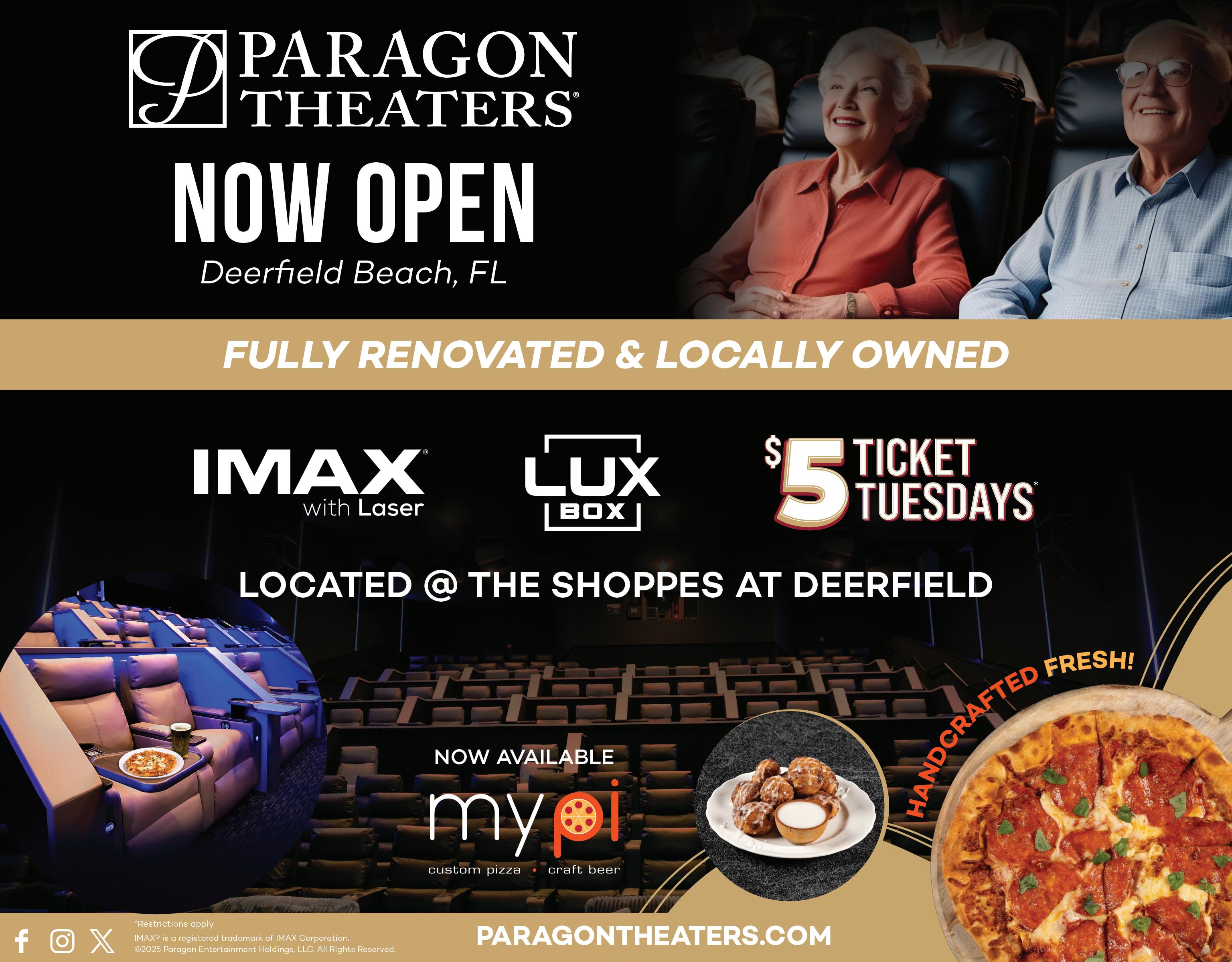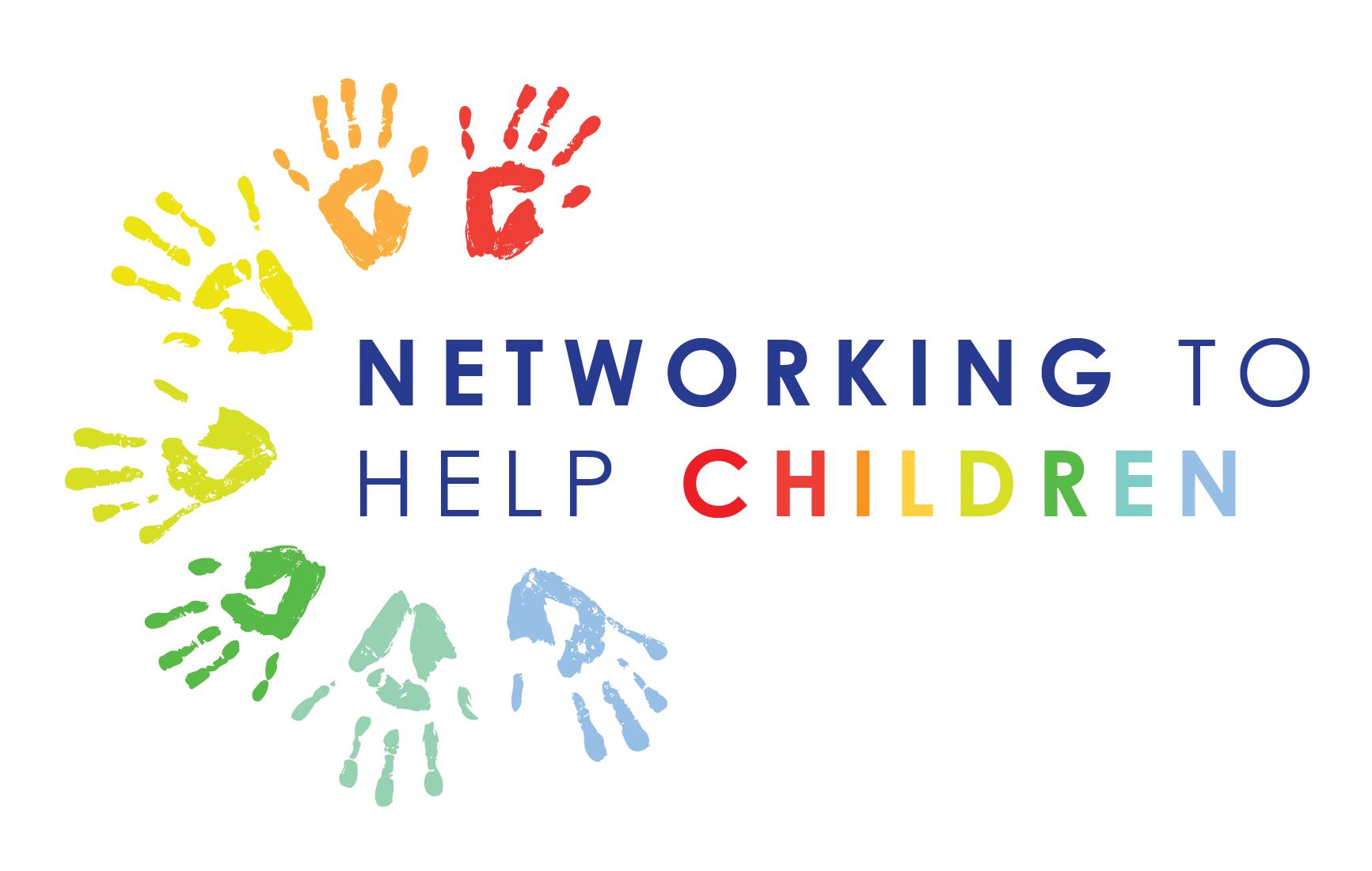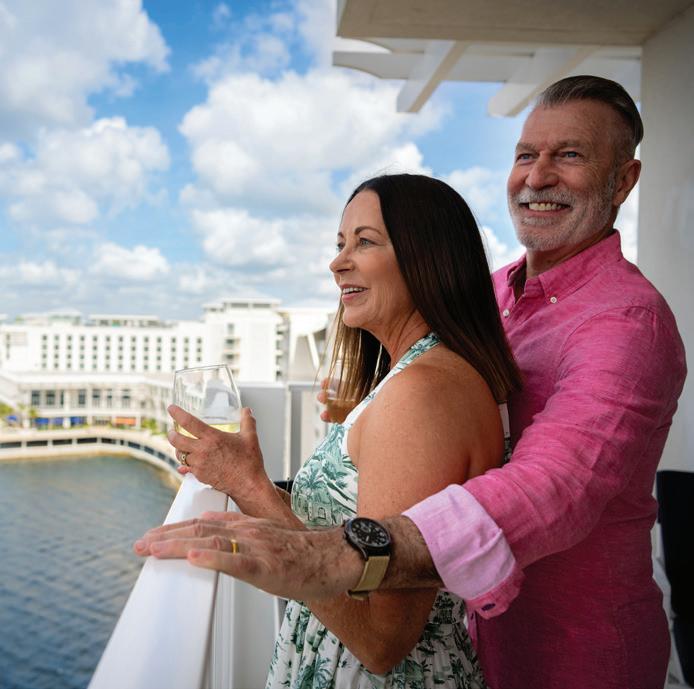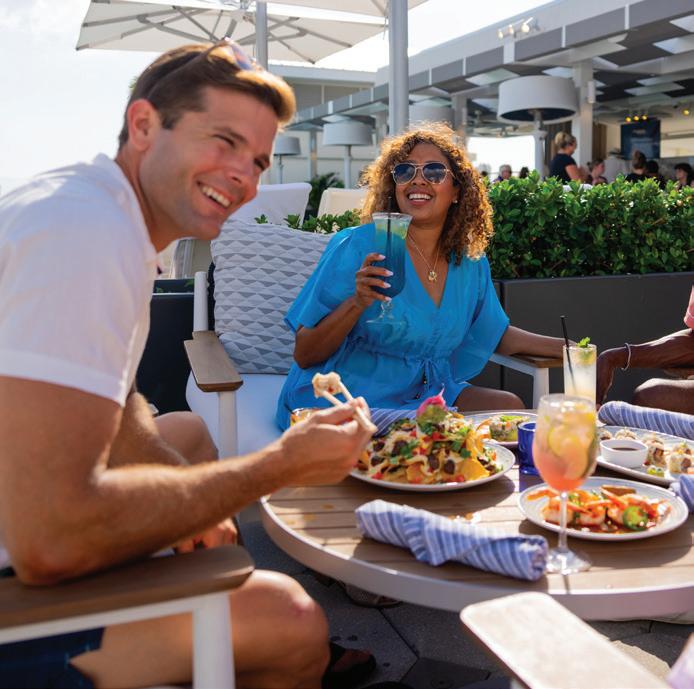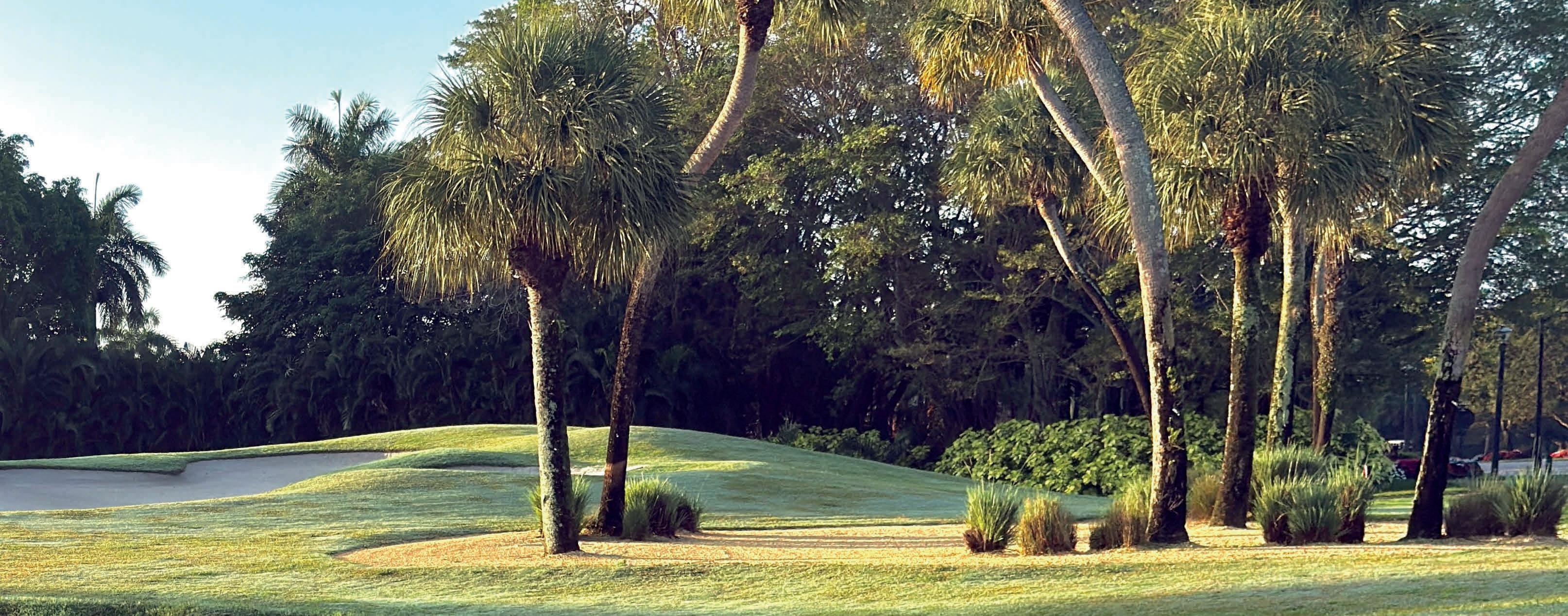
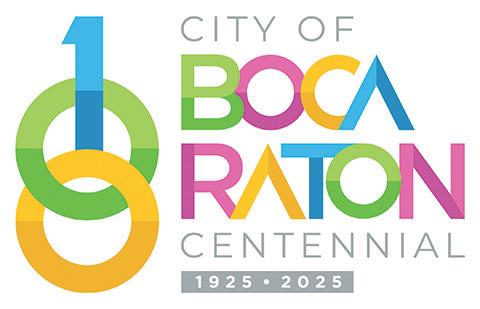



In celebration of Boca Raton’s Centennial year, the Boca Raton Historical Society, in partnership with Festival of the Arts Boca, is presenting a special edition of its popular Summer Sips & Sounds series at The Schmidt Boca Raton History Museum (71 North Federal Highway) that ends with a free Centennial Concert Finale at the Mizner Amphitheater.
“Summer Sips & Sounds has always been a crowd favorite, but this year we’re taking it to a new level to mark Boca Raton’s 100th birthday,” said Mary Csar, Executive Director of the Boca Raton Historical Society.
The collaboration marks the continuation of a shared mission to honor and elevate Boca’s cultural legacy, including the recent Centennial Celebration concert that closed out this year’s Festival of the Arts Boca. That performance, co-presented by the Boca Raton Historical Society, brought to life 100 years of Boca history through the music of such icons as Sinatra, Tommy Dorsey, KC and the Sunshine Band
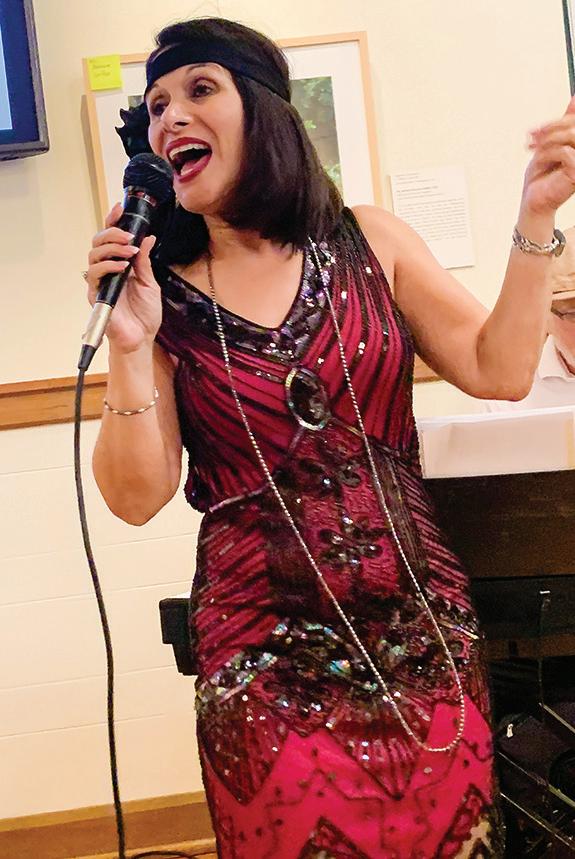
Joanna Marie Kaye brought the Roaring 20s to life with sparkling vocals and vintage flair during last year’s “Ragtime Revival” at Summer Sips & Sounds.
An audience of about 200 Broken Sound members discovered to their delight and amazement in May why third generation psychic and mentalist Michael Gutenplan has drawn crowds across 49 states and 23 countries with his unmatched mentalism show.
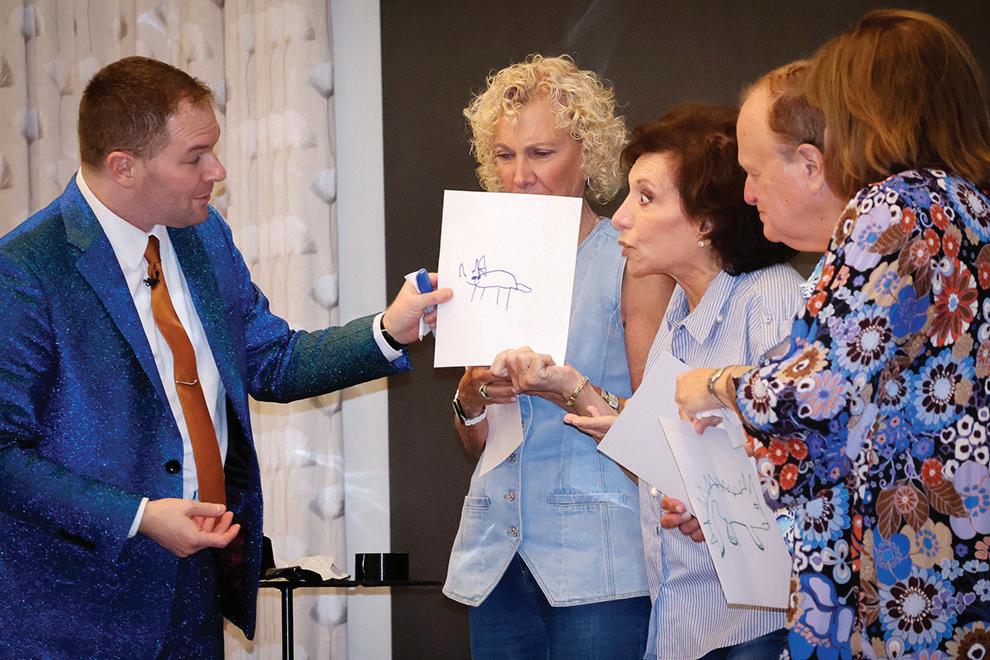
A featured performer at the legendary Magic Castle in Hollywood and a consultant for film and television, he is a member of the Psychic Entertainers Association, the Academy of Magical Arts, and holds a degree from the prestigious Carnegie Mellon University School of Drama.
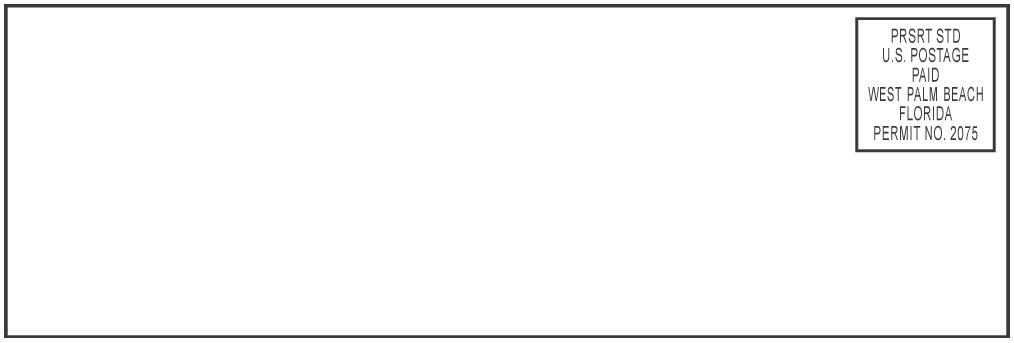
With Pickleball having rapidly taken its place as the fastest-growing popular participation sport in America—and our own Boca Raton Picklers winners of the 2024 National Pickleball League Championship—it did not take long for this city’s forward-thinking Mayor Scott Singer and City Council to come up with a way to put Boca Raton on the sport’s map in a world class way!
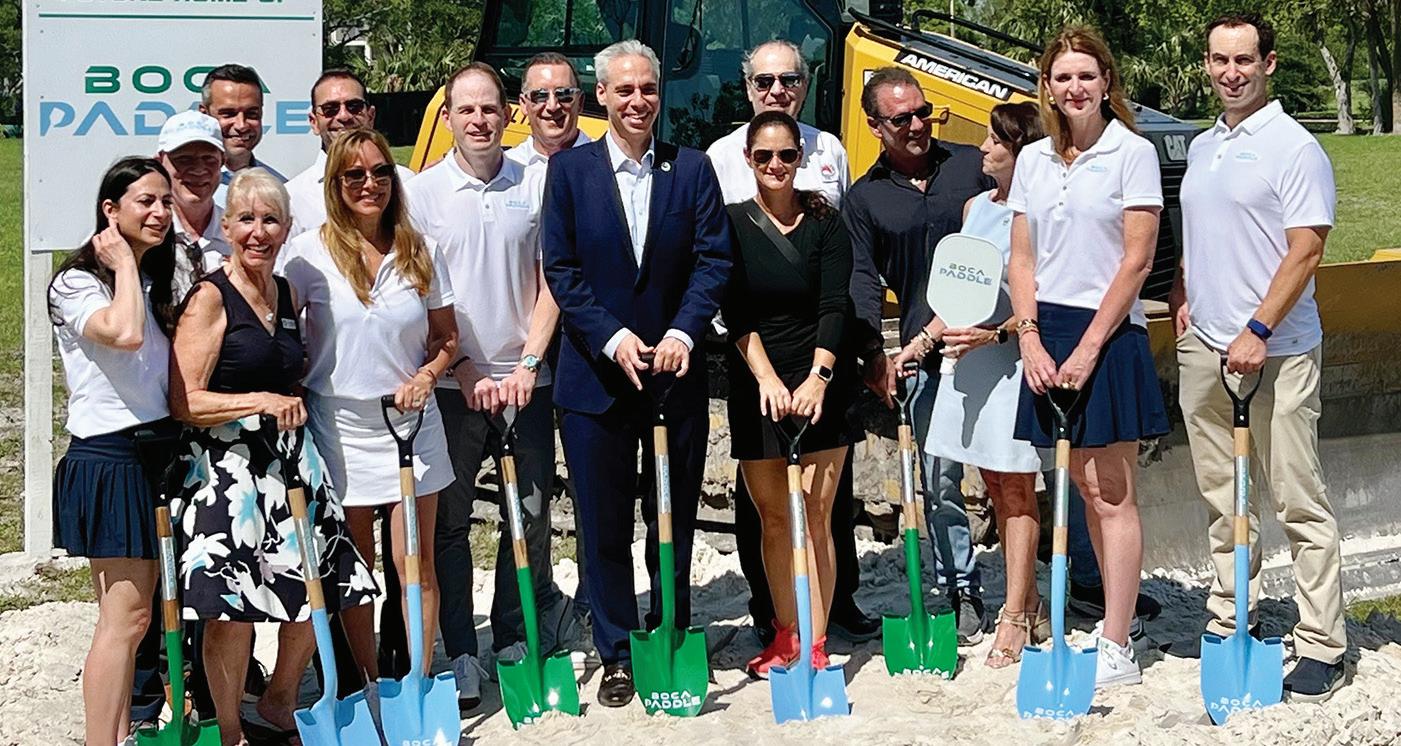
Football fans nationwide will be aware of 2025 as Boca Raton’s Centennial year when they tune into the 12th annual Boca Bowl game at 2 p.m., Tuesday, December 23rd. That is when ESPN-TV and ESPN Radio will cover the event from Flagler Credit Union Stadium on the campus of Florida Atlantic University. The game will be broadcast locally on ESPN 106.3.
“The Boca Raton Bowl continues to be a can’t-miss celebration of college football and this year will be no exception. We’re excited to once again showcase top-tier talent and deliver a first-class experience for fans, partners and the community,” said Boca Raton Bowl executive director Doug Mosley.

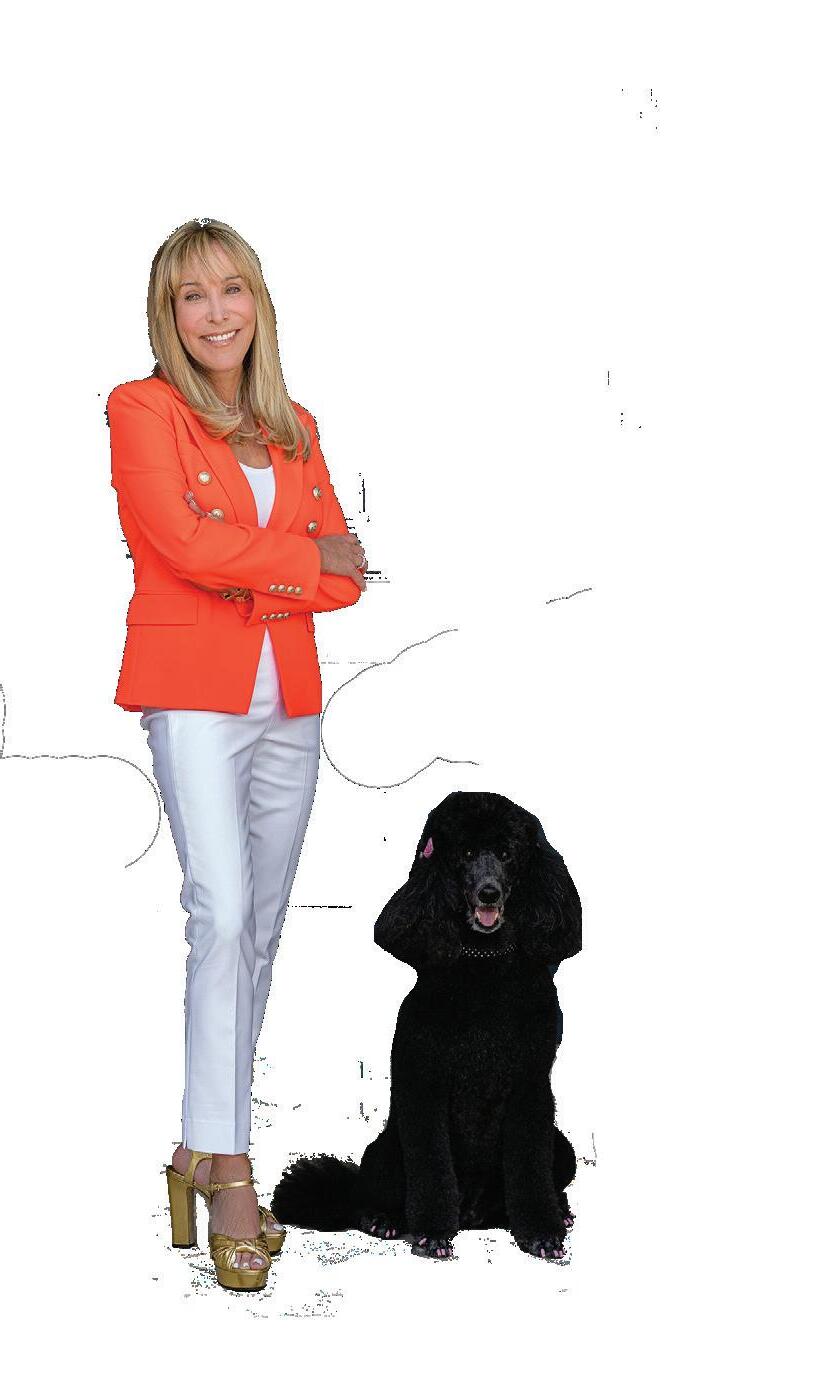










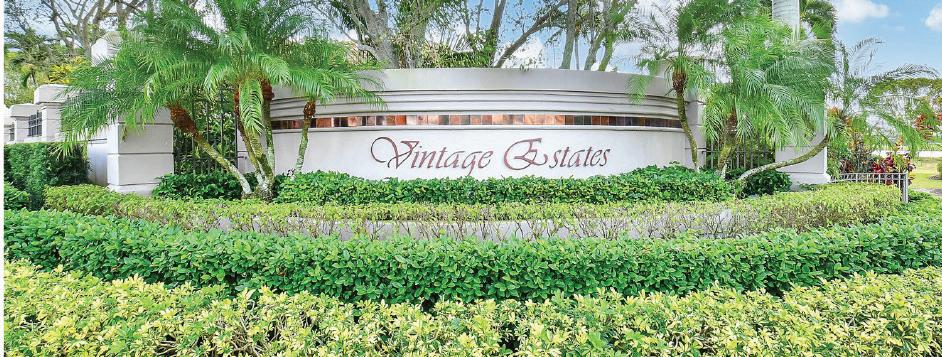





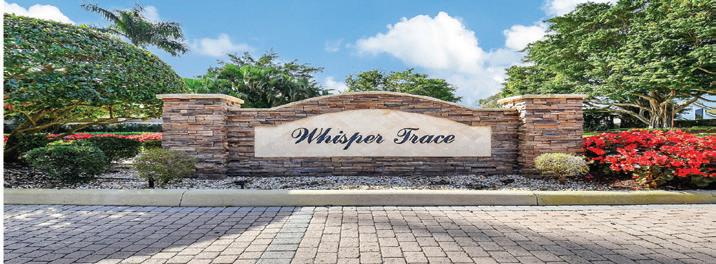






America’s Top Psychic-Master Mentalist Amazes from page 1
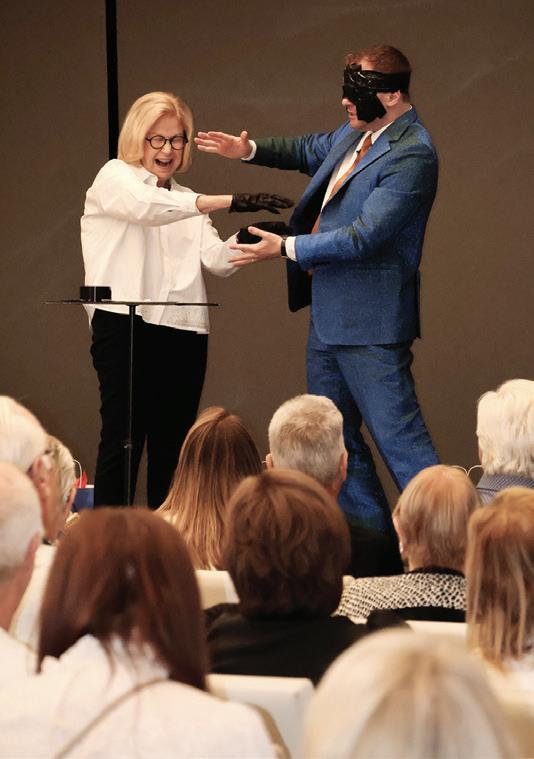
In keeping with the creative lineup of events scheduled yearround for Broken Sound members—together with beverages and refreshments arranged by Broken Sound—Michael demonstrated a wide range of his remarkable skills on May 28th in the clubhouse’s Illuminations Ballroom, each of which involved active audience participation and enthusiastic applause for results almost impossible to believe!
Interestingly, as Michael himself expressed it, the purpose of working with various members of the audience was to “help unlock their psychic potential.”
Among the most dramatic moments during the show were the following:
- Michael became a human lie detector, knowing who was lying based on the member’s body language. This was followed by an amazing drawing duplication using cold reading techniques.
- Members of the audience called out random numbers, and after adding them up the total was the exact date, hour and minute (528250847) of that very moment: May 28, 2025, at 8:47 p.m.!
- Michael read the minds of various audience members as they thought of cards, places and people.
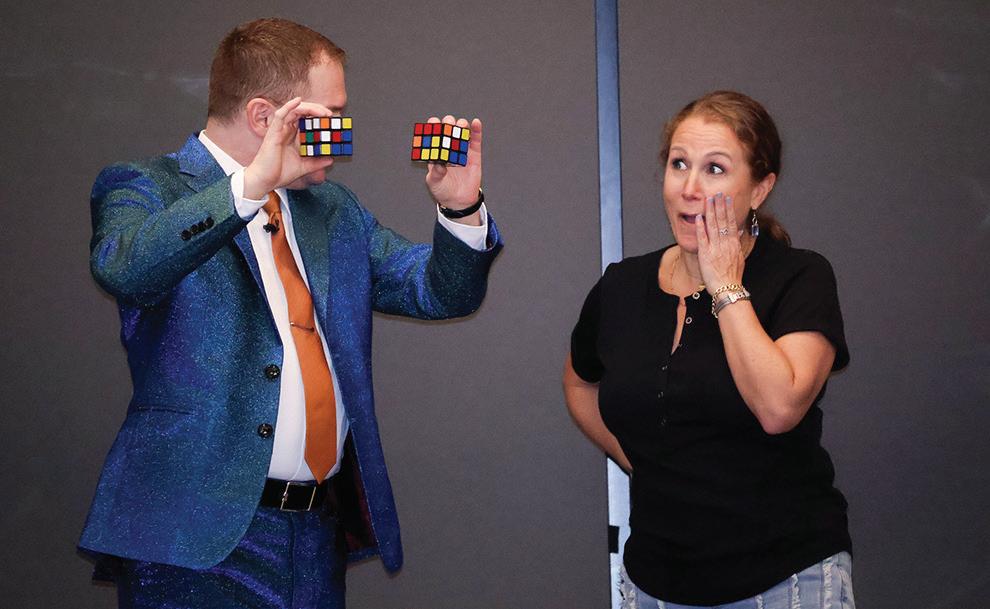
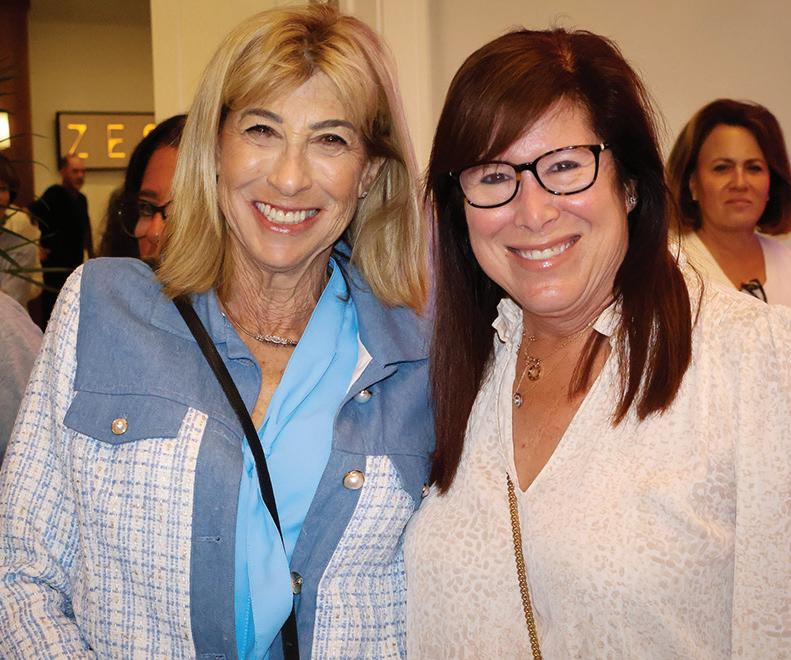
Dr. Rosenbusch has been practicing dentistry for 34 years and has extensive experience in many aspects of dentistry. His main focus is on Cosmetic Dentistry, Laser Dentistry and Implant Prosthetics
- An audience member solved a Rubick’s Cube behind her back!
- While blindfolded Michael performed incredible displays of his psychic abilities, including knowing items presented to him and following a drawn path.
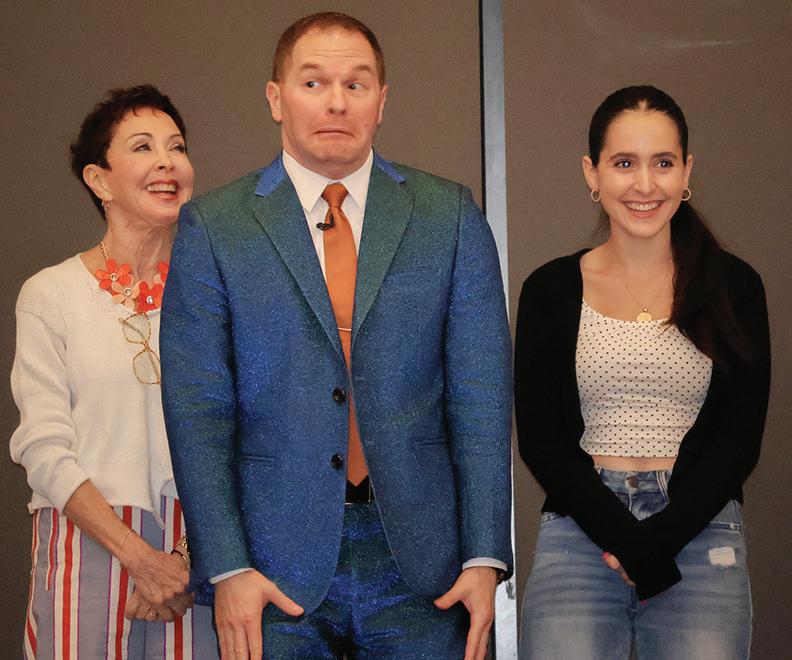
- At the end of the show Michael showed that he had predicted members’ randomly drawn animals by surprising everyone with stuffed animal versions of these drawings!
The Broken Sound members gave Michael Gutenplan a well-deserved ovation at the end of the show, after which he chatted with those who stayed and performed several more effects in appreciation.
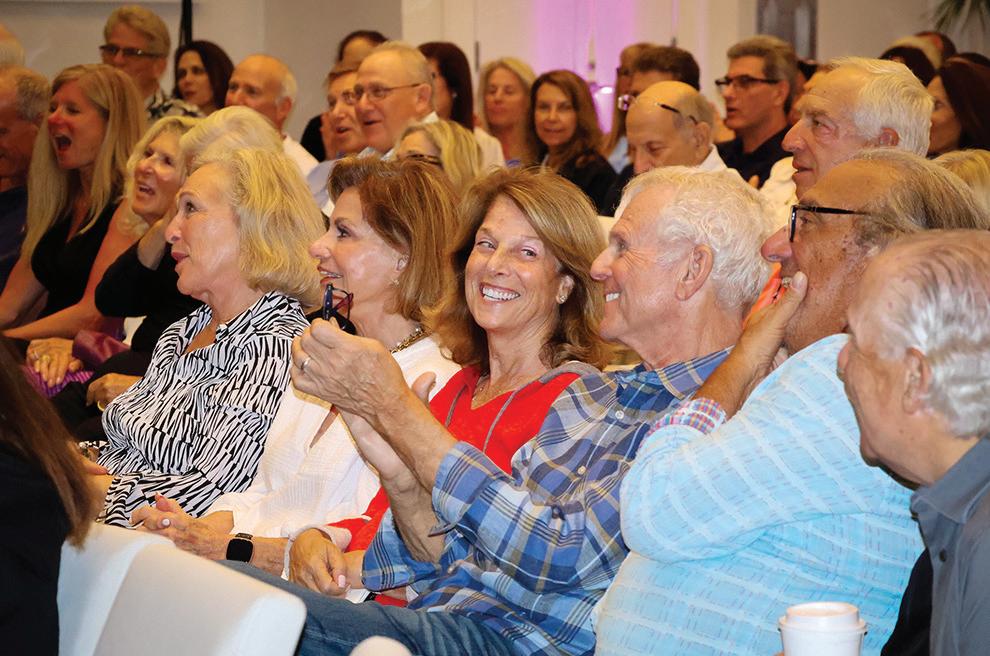

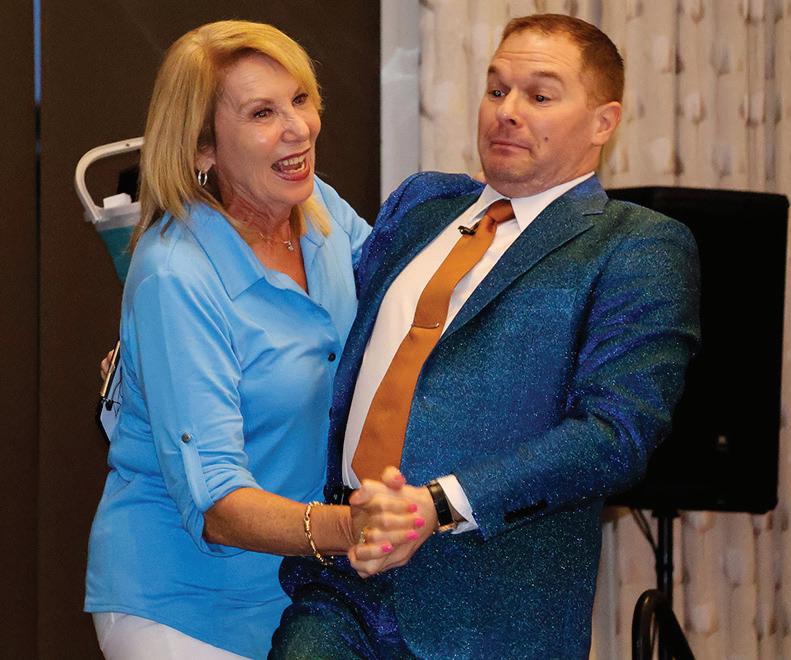
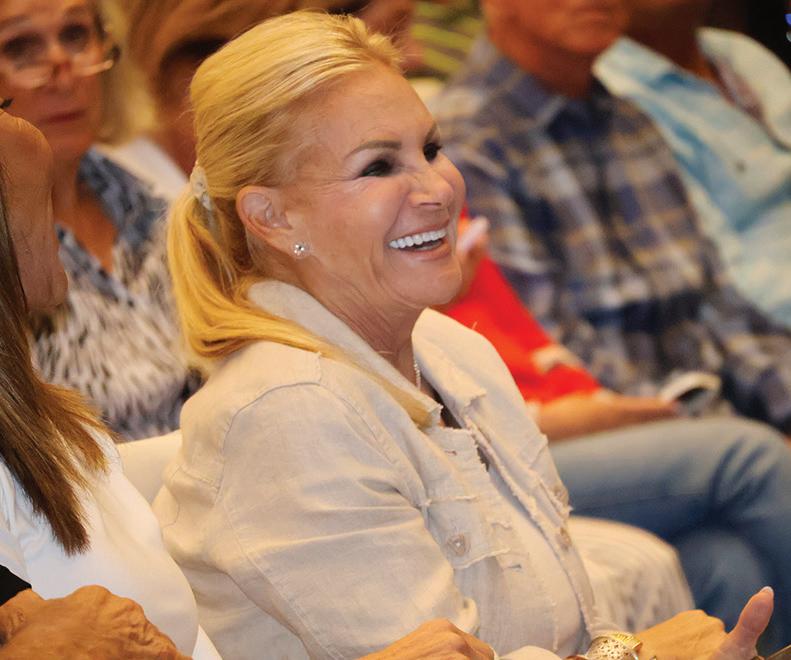

bocadentist12@gmail.com
City Breaks Ground for “Boca Paddle,” from page 1
On June 10th a groundbreaking ceremony took place as part of an announcement that a 100,000-square-foot facility is being built for “Boca Paddle,” a combined indoor climate-controlled and covered outdoor venue that will offer 25 world-class paddle courts available on a modest fee basis: 19 for Pickleball and 6 for Padel, a variation of the sport that is popular in South America and played by many in Florida.
The venue is designed for the enjoyment of all residents of Boca as we enter the second century of the city’s history. Anticipated to be especially exciting for many is the fact that players will be invited to join teams and leagues of all ages and skills. It will also offer playing lessons, a pro shop, gym, shared workspace, saunas, locker rooms, plunge pools and a full-service health food-focused restaurant and bar.
“This groundbreaking facility positions Boca Raton to cement its status as the paddle capital of the world,” said Brian Levine, a member of Broken Sound club and of the championship Picklers team, as well as Board Member of United Pickleball Association and the first CEO of Major League Pickleball. “Of the current top 10 ranked pickleball players globally, seven reside in the Boca Raton area. and that is a function of the sheer density of passionate pickleball players who reside in our community.”
The entire Boca Paddle project, which is scheduled to open in March 2026, is a private/public partnership backed by the City of Boca Raton and a team of investors, developers and others dedicated to enhancing the community’s access to the sport, among them: Butters Construction, CityPickle, farm-to-table restaurant Farmers Table, country club operator Life Time, MLP team owners Al Tylis, Richard Chaifetz and Ron Saslow, as well as local professionals Ben Johns, J.W. and Joria Johnson, Anna Bright and Gabriel Tardo.
and others. Conducted by Kyle Prescott and featuring the Festival Boca Jazz Orchestra, the concert also included the world premiere of a commissioned piece by FAU composer Kevin Wilt.
Now the celebration continues with a nostalgic, three-part musical journey through the 1920s, 1940s and 1950s, complete with themed fashion, vintage tunes and a toast to Boca’s past—and culminating in a free community concert reprising the Festival’s spectacular finale.
Each evening will include light bites and wine reception, live performance and a meet-and-greet that features a dessert reception with the performers. Signed copies of the Boca Raton Historical Society’s commemorative Centennial book will be available for purchase.
The three “Sips & Sounds” performances are: Thursday, July 17th, 6 p.m. to 8 p.m. Ragtime Revival: The Roaring 20s. Boca was just getting started, and so was the Jazz Age! Dance the Charleston and sing along to such toe-tapping tunes as Ain’t She Sweet and Tea for Two . With the sparkle of speakeasies and the rhythm of early jazz this era was all about fun, freedom and flair.
Thursday, August 21st, 6 p.m. to 8 p.m. Boca in the 1940s. WWII brought the world to Boca Raton! The big band sound took center stage with such legends as Glenn Miller and Tommy Dorsey keeping spirits high and feet moving at the Boca Raton Army Air Field. From Boogie Woogie Bugle Boy to Sentimental Journey , relive the swing, sass and style that defined the decade.
Thursday, September 18th, 6 p.m. to 8 p.m. Fabulous Fifties: The Ella and Louis Years. Celebrate the golden age of jazz with hits inspired by legends Ella Fitzgerald and Louis Armstrong and other popular artists of the time, evoking the style and soul of the 1950s.
Tickets are priced at $40 per person per event, or $108 for the full series. Includes wine, light bites, dessert, and a post-show social. Tickets at www. BocaHistory.org.
Special Free Concert
Saturday, November 1st , Free Community Event: Special Centennial Concert Finale at the Mizner Park Amphitheater. Doors open: 7:00 p.m.; Concert: 8:00 p.m. A reprise of the fabulous 2025 Festival of the Arts Boca Concert, presented free to the community by the City of Boca Raton. Through sight and song, this multimedia Big Band extravaganza will take audiences on a journey through Boca’s past–from its founding to today.
If you are of an age when “Pop Culture” was your thing, or can just appreciate the fun of it all and want to share a slice of it with your family, you won’t want to miss the exhibit currently at the Cornell Art Museum in Delray Beach’s Old Town Square. Cornell Art Museum admission is free. Donations are welcome.
This exhibit is on view through September 28th and highlights the works of six fearless and forward-thinking artists:

• Harold Caudio –Haitian American, South Florida mixed-media artist who creates pieces that challenge stereotypes, celebrate diversity and spark dialogue. “Pop Culture” will feature Caudio’s series of portraits of influential figures (including Janet Jackson and Tupac) made entirely out of Skittles candy. Caudio was inspired to use Skittles after hearing the tragic story of Trayvon Martin, who was carrying a bag of Skittles and an iced tea when he was fatally shot. The Skittles became a symbol of Martin’s innocence and youth.
• Gwak – Sarasota-based artist known for his immersive, nostalgia-driven art installations that blend pop-culture references and oversized sculptures. His works include a
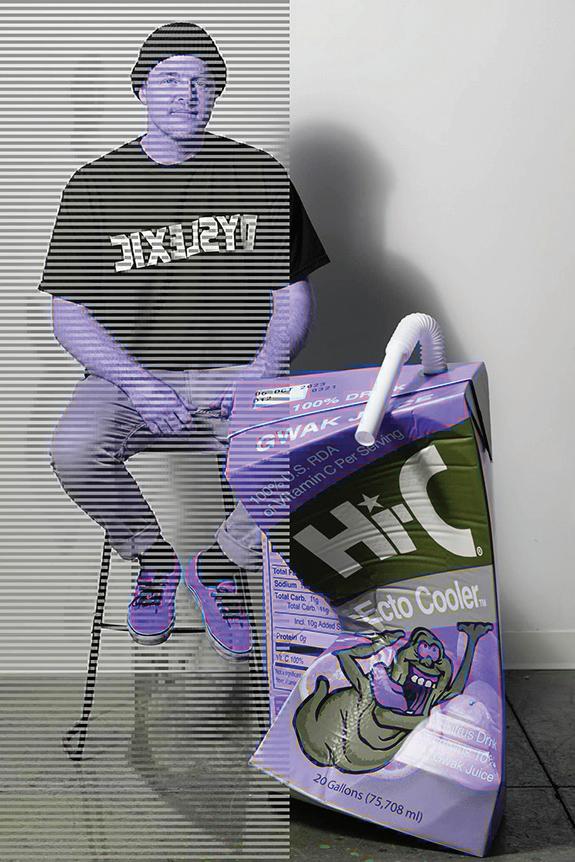
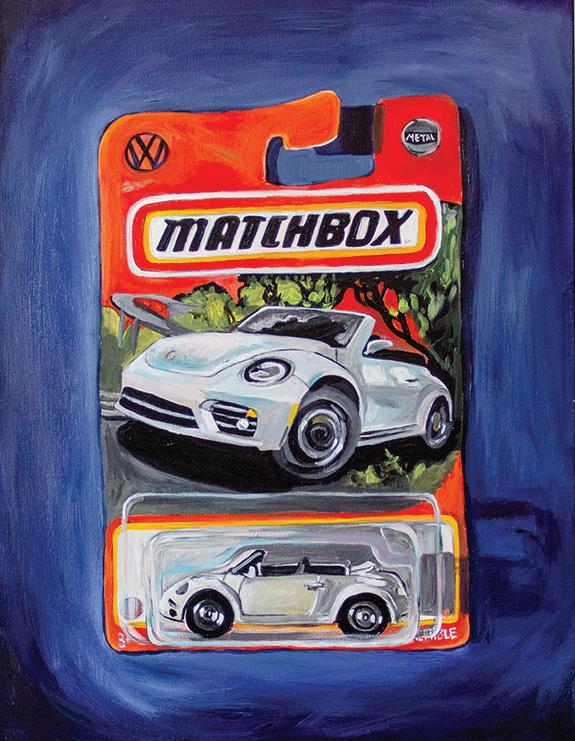
giant Rock ’em Sock ’em Robot, Hi-C juice box and Furbies.
• Ashleigh Walters – Former TV news anchor turned painter and sculptor known for her whimsical, oddly scaled creations and imaginative flair.
• Annina Rüst – Jupiter-based artist-technologist pushing the boundaries of electronics and software -based media art.
• Rogerio Peixoto – Brazilian-born South Florida talent creating 3-D sculptures and pop paintings on mirrors.
• Damian Fitzsimmons – South Florida artist and Creative Director, film maker, writer and director of Braveman Media. “Pop Culture” will feature his interactive ray gun art.


More than a dozen First Responders, law enforcement and military veterans walked 15 miles recently as Beachway Therapy Center partnered with Stomping Out the Stigma on its 4th annual walk to increase awareness of the need for mental health awareness and services for this important Palm Beach County group.
The walk, which started at the City of Greenacres Fire Rescue Department’s Fire Rescue Station 94, concluded in West Palm Beach at Beachway Therapy Center to a crowd of cheering supporters.
City to Top Off Centennial Year from page 1
The Boca Raton Bowl, a postseason college football bowl game owned and operated by ESPN Events, has agreements with five conferences (American Athletic Conference, Conference USA, Mid-American Conference, Mountain West Conference, Sun Belt Conference) plus select independents for berths in this year’s game. The game has logged 11 successful years with cumulative viewership surpassing 30 million households and total sponsoring value over $250 million. More than 50 Boca Raton Bowl alumni have gone on to be selected in the NFL Draft and dozens more have entered the league as undrafted free agents.
The two teams selected to compete in the 2025 Boca Raton Bowl will be announced on December 7th following the weekend’s conference championship games.
“Each year this game brings the energy of bowl season to life in a setting unlike any other. We can’t wait to welcome fans, teams and viewers nationwide back to Boca Raton and the Palm Beaches,” added Mosley.
For game, ticket and sponsorship information visit BocaRatonBowl.com and follow Boca Raton Bowl in the pages of Boca Club News and on Instagram, Facebook, Twitter/X and YouTube.
About ESPN Events. ESPN Events, a division of ESPN, owns and operates a portfolio of collegiate sporting events nationwide. In the 2025-26 academic year the 35-event schedule includes three early-season college football kickoff games, 17 college bowl games, 10 college basketball events, two college volleyball events, the premiere regular season college softball and gymnastics events, as well as the Band of the Year National Championship. Collectively, these events account for over 400 hours of live programming on ESPN platforms, reaching 60 million viewers and attracting more than 650,000 annual attendees. Each year the portfolio of events features more than 20 Division I conferences and hosts over 4,000 participating student-athletes. With satellite offices in more than 10 cities across the country, ESPN Events builds relationships with conferences, schools and local communities, as well as providing unique experiences for teams and fans.
“This was a great opportunity to help First Responders deal with the intensity of what they face day in and day out on the job. They are always there for us and we wanted to show them that we are here for them, too,” said Tim Roberto, founder of Stomping Out the Stigma and event organizer.
Stomping Out the Stigma is a 501(c)(3) nonprofit that helps provide access to confidential, lifesaving counseling to veterans and First Responders in Palm Beach County and beyond. According to the Florida Department of Health’s First Responder Suicide Summary published in 2023, Palm Beach County First Responders had the highest number of suicide deaths from 2017-2022.
Roberto, a U.S. Marine veteran and Director of Community Relations at Beachway Therapy Center, along with Greenacres Fire Chief Brian Fuller and others, helped
raise thousands of dollars in support of the organization’s mission. Funds raised help provide access to confidential mental health sessions with licensed clinicians who specialize in trauma, mental health, substance use disorders and family issues. An example of this is Beachway Therapy Center’s “After the Call” program, which offers specialized therapy to help First Responders dealing with trauma.
About Beachway Therapy Center. Located in Palm Beach County since 2008, Beachway Therapy Center is a nationally recognized provider of addiction and mental health treatment with a specialty in treating individuals who suffer from cooccurring mental health disorders. By providing evidencebased and innovative holistic therapy, its team of dedicated and experienced professionals empowers its patients to recover in a safe and private environment.
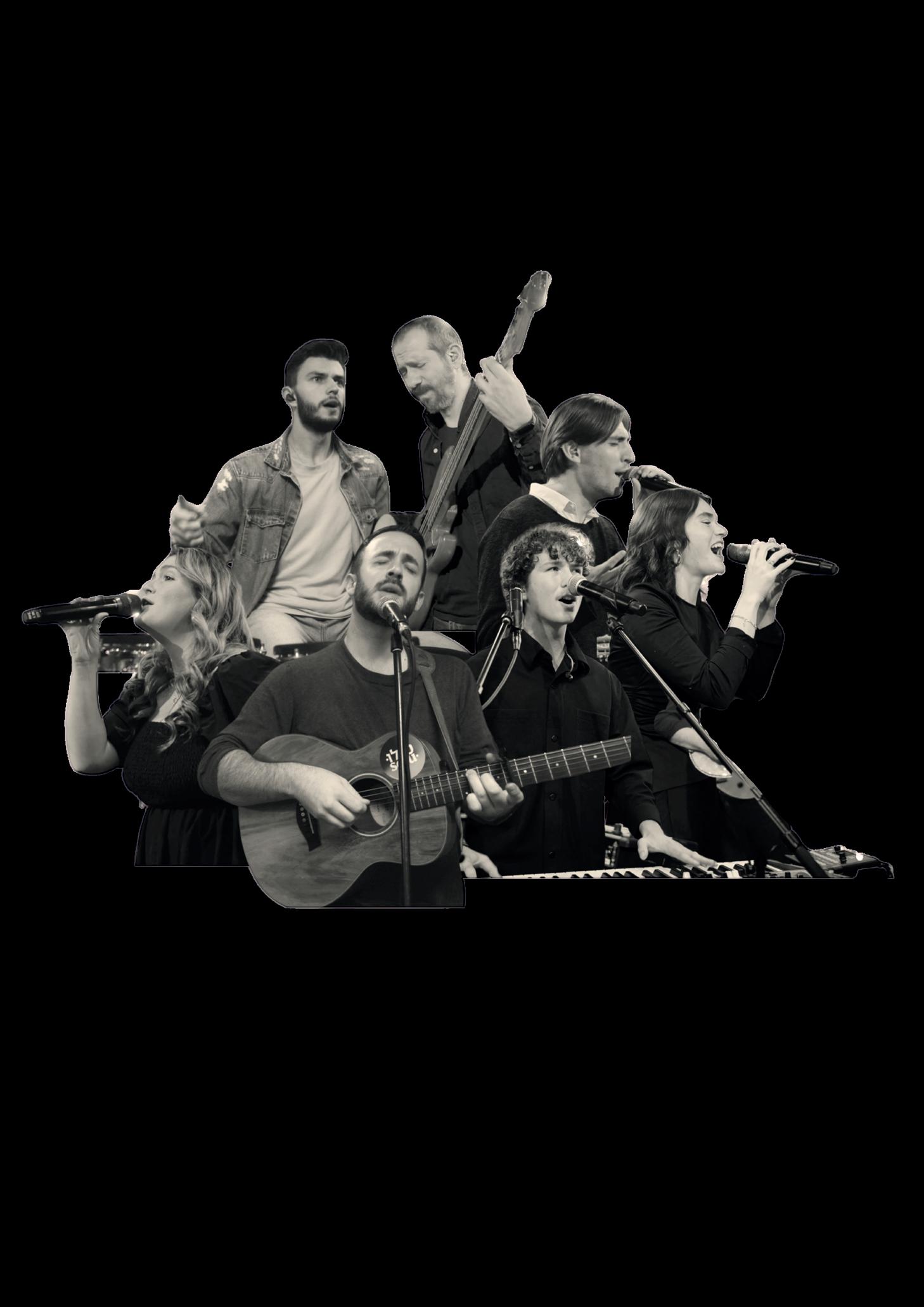














I have cash buyers that are currently looking for the following. Call me now if you are thinking of selling in the near future.
Buyer 1. Courtyard style home up to 3.6 million depending on condition
Buyer 2. Single family home up to 2 million. They will renovate if needed.
Buyer 3. Home with 2 bedroom plus a den. 800k-1.5 million. They will renovate.
Buyer 4. Home in Whisper Trace, Laurel Point or Timber Mill with primary suite on the ground floor

The Delray Beach Downtown Development Authority (DDA) will once again celebrate Florida’s Official Jimmy Buffett Day with a “Party in Paradise”: Delray’s Tribute to Jimmy Buffett. The concert will take place August 30th at Old School Square and will feature the Caribbean Chillers, the Official Jimmy Buffett Tribute Band. Attendees can expect a laid-back atmosphere with margaritas and music, a costume contest, limbo competition, coconut painting and lots of games and fun. Tickets are now on sale.
The Caribbean Chillers Show is described as an “authentic” recreation of what you will hear and experience at a Jimmy Buffett Concert. The opening acts feature Cape Universal, a local reggae band and Spred the Dub, an eclectic mash-up of grooves and “riddems” incorporating elements of reggae, jazz, funk, soul and good old rock ’n’ roll.
Here is the schedule for the day, Friday, August 30th: 5:00 p.m. Toast to Jimmy Buffett for the kick-off of Party in Paradise.
5:00 p.m. - 6:10 p.m. Cape Universal Band & Limbo and Costume Contest.
6:20 p.m. - 7:45 p.m. Spred the Dub
8:00 p.m. - 10:00 p.m. The Caribbean Chillers
WHERE: The Amphitheatre at Old School Square, 51 N. Swinton Avenue, Delray Beach. Parking is available in Old School Square garage.
TICKETS: General Admission tickets (bring your own lawn chair) are $25; kids 12 and under are $5, kids 2 and under are free. VIP Admission is $60 and includes access to an exclusive VIP lounge, seating, dedicated bar and one free drink ticket. Food and beverage vendors will be on site. No outside alcohol is allowed in the venue.
Rain or shine, everyone is invited to don your best Hawaiian shirts, chew some Juicy Fruit and head to Old School Square for a sun-soaked Party in Paradise! Grab some takeout from a local favorite or enjoy food and drink options from on-site vendors and get ready to dance the
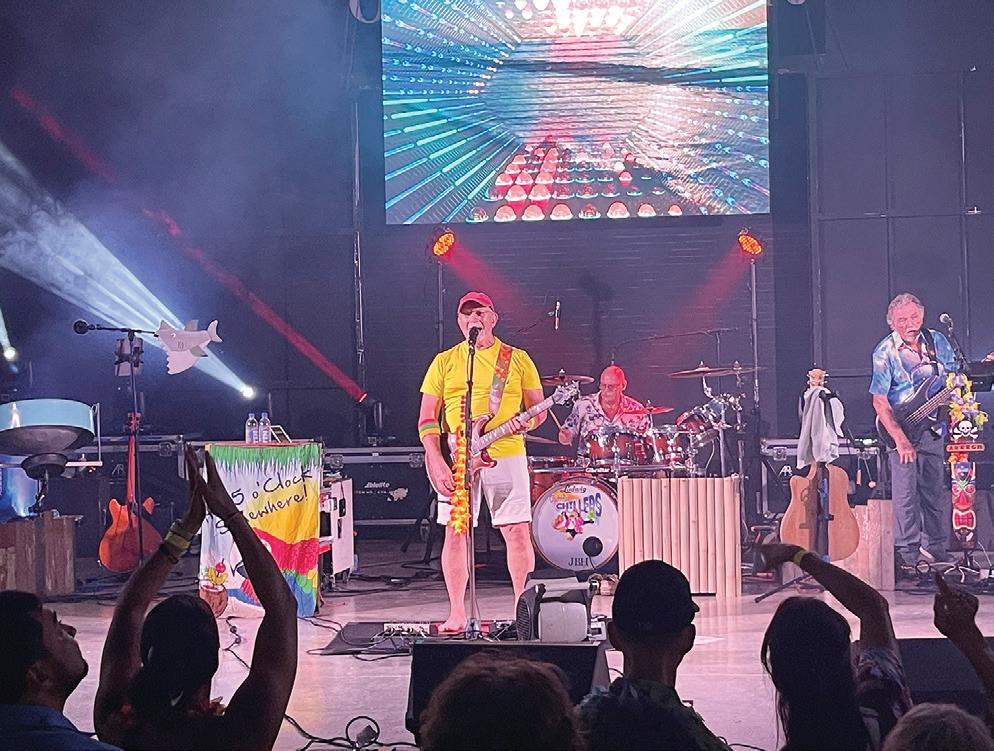
night away under the stars. For more information and to see a full list of events at Old School Square, visit: https:// delrayoldschoolsquare.com/events.
Arts Garage, a Visual & Performing Arts venue located in Delray Beach that connects the community to the world through the arts, will present The Art of Laughter with Vien Phommachanh and Mark Christopher on Friday, August 1st, from 8 to 10 p.m. Dr. Phommachanh is a practicing ear, nose and throat doctor in Sarasota, FL, who brings his unique perspective to the stage. His comedy is an anecdotal stew of funny medical experiences, a stressful Laotian upbringing and some mixed-racial marital spice.
Tickets are $40 (including fees) and are available for purchase by calling the Arts Garage at (561) 450-6357 or by visiting https://artsgarage.org/event/the-art-of-laughterwith-headliner-vien-phommachanh/.
Vien Phommachanh has performed stand-up comedy across the United States and internationally, with stops in Los Angeles, Chicago, Nashville, Boston, Toronto, The Atlantis Resort in the Bahamas and Adelaide, Australia. He has participated in numerous comedy festivals, including
The Asheville Comedy Festival, World Comedy Expo, Clean Comedy Challenge, Main Event of the World Series of Comedy in Las Vegas, North Carolina Comedy Festival and Adelaide Fringe. Known for his appearances on CBS and a DryBar Comedy Special that featured one of the top 10 clips of 2024, Vien is currently touring with the Heroes Off Duty and White Collar Comedy Tours.
Award-winning Peruvian trumpeter Dante Vargas and his daughter, vocalist Val Vargas, will be on stage at Delray’s Arts Garage on Friday, July 25th, with an enthralling evening of Salsa Dura and Boogaloo that promises to have audiences dancing to the vibrant fusion of Mambo, Salsa and Latin Jazz. The performance will run from 8 to 10 p.m. Tickets range from $50 to $55 (including fees) and are available for purchase by calling the Arts Garage at (561) 450-6357 or by visiting https://artsgarage.org/event/dantevargas-val-vargas-salsa-dura-y-boogaloo/.

Dante Vargas, a Grammy Award-winning trumpeter, arranger and producer, has worked with such global icons as Marc Anthony, Jennifer Lopez, Sergio George and Grupo Niche. With a career spanning more than two decades he is known for his technical brilliance and ability to fuse genres while maintaining the raw soul of salsa. Val Vargas, a gifted singer and bandleader, brings a fresh

and fiery voice to the stage, reviving the funky vibes of the 1960s Boogaloo movement with style and charisma. Together they lead The Cat Band, a sizzling ensemble that delivers tight arrangements, punchy horn lines and nonstop energy. Their show at Arts Garage promises a dance-filled night of musical celebration straight from the heart of Latin America.


The Morikami Museum and Japanese Gardens is currently offering three exhibitions, two of which illuminate the complex and often overlooked experiences of Japanese women in American history: “Japanese War Brides: Across A Wide Divide” and “Women of Yamato.” The third explores a rare and mesmerizing form of Japanese craftsmanship. All three will be on view through September 28th.
“Japanese War Brides” explores the lives of the nearly 45,000 Japanese women who immigrated to the United States as wives of U.S. military servicemembers after World War II. These young women left their homes and families to navigate the complexities of postwar American society. Their arrival marked the largest women-only immigration event in U.S. history, increasing the Asian American population by 10% by 1960, according to the Smithsonian.
In contrast to other immigrant groups, Japanese war brides were often isolated, settling in U.S. cities and towns, typically without familial, linguistic or cultural support. Yet they demonstrated remarkable resilience, learning English, adapting to American customs and becoming integral members of their communities. Many worked in or started businesses, raised families and slowly began to shift public perception. Their quiet determination helped change the reception and acceptance of Asian cultures, paving the way for future generations of immigrants.
The exhibition has been produced in collaboration with The War Bride Experience, Inc., the Smithsonian Institution Traveling Exhibition Service and The Smithsonian National Museum of American History.
Accompanying this national collection is “Women of Yamato,” a complementary exhibit that highlights the Japanese women who helped shape South Florida’s Yamato Colony and surrounding communities. Their legacy is a testament to cultural preservation, quiet
strength and generational impact told through oral histories, photographs and personal artifacts.
The third exhibition, “The Art of Peace: Jizai Okimono,” features 19 exquisite jizai okimono —intricately articulated sculptures crafted in the likeness of animals and mythical beasts. Made of finely worked metals, these pieces showcase the extraordinary skill and creativity of Japanese armorers who, during a time of peace in the Edo period (1603–1868), transitioned from forging samurai armor to creating works of art.
The Art of Peace: Jizai Okimono offers a unique opportunity for visitors to witness the articulated sculptures of insects, birds, reptiles, fish and mythical creatures like dragons, whose bodies flex and coil in breathtaking realism. These lifelike creations reflect not only the technical mastery of their makers but also a deep appreciation for nature and movement.


With the dawn of the Meiji period (1868–1912) and the transformation from a feudal military government to a constitutional monarchy, metalsmiths rechanneled their expertise into artistic pursuits. The term jizai means “movable” or “articulated,” while okimono refers to ornamental objects. The result is a fascinating collection of jointed sculptures that are both technically impressive and visually enchanting.
“The Art of Peace: Jizai Okimono” is drawn from a distinguished private collection and is made possible in part by generous support from The Henri and Tomoye Takahashi Charitable Foundation and the Rhodes and Leona B. Carpenter Foundation.
Morikami Museum and Japanese Gardens is located at 4000 Morikami Park Road, Delray Beach. For more information, call (561) 495-0233 or visit morikami.org, and follow on social @morikamimuseum.

Scott Singer is the 35th Mayor of Boca Raton and was re-elected in 2023. A South Florida native, attorney and small business owner, Scott and his wife Bella live in Broken Sound with their two children.
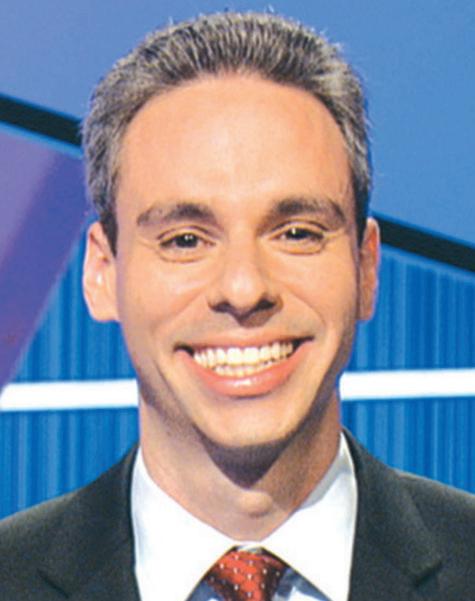
After many years of discussions, meetings and community input, the city continues to progress in transforming our outdated downtown government campus into a thriving community-oriented gathering place.
At our June meeting the City Council directed staff to move forward with the next steps toward achieving what will be a generational project that will fulfill our long-term vision and top priority to replace aging facilities with modern, top-notch amenities that our residents deserve.
Earlier this year the City Council carefully selected Terra & Frisbie Group as our partner to create a destination that best serves our residents. Their plans include building a new City Hall and Community Center and adding a mix of offerings, including residences, a hotel, offices, shops and restaurants to create a district that provides benefits to residents after regular business hours.
With national interest from top developers to revitalize our disjointed government campus the City Council opted to choose partners who have shown they will listen to what our residents want to see in this new destination that capitalizes on our Brightline station and proximity to our beloved Mizner Park.
We are still working out many specifics in the coming weeks and months, but we know that this project should generate billions of dollars over its life in tax revenue alone, including hundreds of millions of dollars in current value to enable the city to have the public resources that residents need, want and expect. The fact that details are still in progress means that residents have plenty more opportunities to provide input and feedback – in addition to the more than 25 noticed meetings in the past year and a half.
The process is dynamic by design. The City Council opted to pursue a method to complete this project that is flexible, allows residents to share their ideas and is the most cost effective. To ensure that residents are involved in the plans the City Council selected to utilize a public-private partnership, which is a collaboration between a government agency and private-sector company, often on large-scale infrastructure projects. In addition to leveraging private-sector expertise, innovative approaches, access to capital and a slew of other benefits, P3s enable governments and their partner to deliver projects more effectively and efficiently with flexibility.
The framework for what we envision is taking shape thanks to community input over the dozens of public meetings so far. Our partners responded to our community’s requests by reducing the number of residential units in the project, further solidifying its plan as a least dense and intense proposal. The plans also commit to creating a walkable district and enhanced recreational and public spaces.
• Tennis in the downtown and at Meadows Park.
• Skate Park developed in partnership with the Beach and Park District at North Park.
• Basketball court downtown.
• Children’s Museum relocated and activated at Meadows Park (which was already scheduled to take place independent of the downtown project).
Another relocation and upgrade will be to our Police Station. The city is moving ahead a long-desired plan to relocate the Police Station to a more suitable location by the Spanish River Library. As our city has evolved it is no longer ideal to locate our police station by the railroad tracks and near a growing pedestrian-oriented district. The project will include a downtown police substation.
The plan also calls for adding offices and a hotel, which will provide an economic boost to our already robust business community and fill the need many residents have sought for new, modern choices to welcome out-of-town guests.
As we continue to strive to attract the best employees and offer residents the top-in-class amenities and services, it is important that we have the facilities to match those high expectations. We are also looking to incorporate an affordable housing component into the partnership agreement, so our hard-working employees have a place to live in the city where they work.
This project comes at an exciting time in our city’s history. As we celebrate our Centennial and our 100 years of success, we are laying the groundwork and vision of our city for the next century.
Building upon the milestone we met in June the city and our partners are working to further refine and improve the plans. Community input and feedback remains essential as the project evolves. Please be sure to provide your feedback through the city’s feedback form or attend an upcoming public meeting – or reach out to me directly.
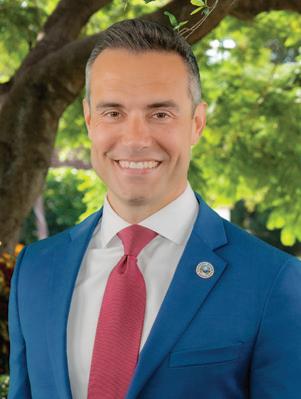
By Andy Thomson, who was reelected to the City Council at the last election after having previously served from 2018-2022. He has lived in South Florida his entire life, except for four college years in Atlanta. Andy resolves business disputes for a living. He is also an adjunct professor at FAU, where he teaches local and state government. Andy and his wife, Joanna, have five young children.
This year Boca Raton is turning 100 years old, and the city has been pulling out all the stops to celebrate its centennial with a packed calendar of community events, festivals, concerts and historical tributes throughout 2025. From live music and food tastings to drone shows and beach cleanups the centennial celebration is designed to bring residents and visitors together in honor of Boca’s vibrant past and promising future.
The official kickoff took place on January 25th with the inaugural Boca Street Fest at Mizner Park Amphitheater. Thousands gathered to enjoy live performances, a bustling beer garden, cultural showcases and a market featuring local artisans and vendors. The event marked the beginning of a dynamic and inclusive year of activities.
One of the city’s signature events, the Centennial Celebration Concert, was held on May 24th and featured rock legends Weezer and Fountains of Wayne. The sold-out concert drew fans from across South Florida and set the tone for a weekend of high-energy entertainment. On May 25th the Boca Raton Innovation Campus hosted a free public Drone Show and Fireworks Finale, offering a breathtaking visual tribute to the city’s history and innovation legacy.
Sports enthusiasts also got in on the action during the James Hardie Golf Tournament, held March 31st to April 6th, which included a special “100th Hole” experience with centennial-themed giveaways and a shaded lounge for fans.
As part of its commitment to community engagement the city launched the Centennial Passport Program, encouraging families to explore local parks and collect stamps for prizes. This initiative, which ran from March through April, culminated in a family-friendly reward system that promoted outdoor activity and local exploration.
Environmental stewardship was also a focus, with Arbor Day Tree Plantings and the Great American Beach Cleanup held in April. Volunteers helped restore mangroves and plant 40 native shade trees in city parks—an investment in Boca’s natural beauty that will last well beyond the centennial year.
Food lovers were treated to the Florida Tacos, Wings & Desserts Battle on April 26th at Sanborn Square. The event
While some of our current recreational offerings will be impacted by the renovation, the city is committed to ensuring that any changes and relocations will be upgrades. Some of the enhancements include:
• New softball fields and upgraded facilities in partnership with the Beach and Park District at Sugar Sand Park.
For additional background information on the project, please visit https://myboca.us/1431/Government-Campus. As always, you can share any thoughts you have at ssinger@ myboca.com, and stay connected on Facebook, X, and Instagram at @scottsingerusa.





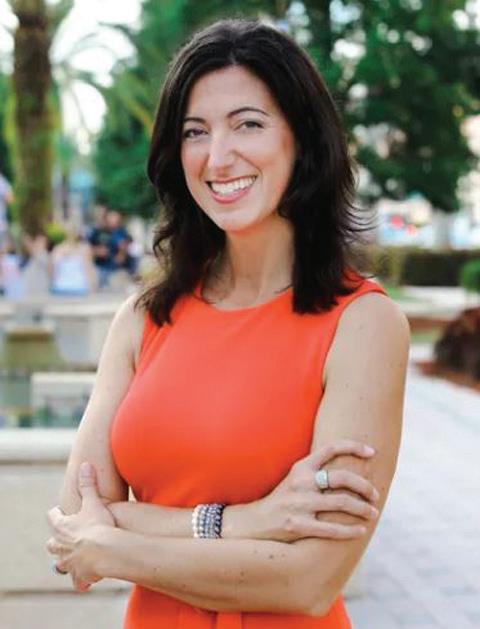
Commissioner Woodward, a 20-year resident of Boca Raton, was elected in November 2022 as Palm Beach County District 4 Commissioner. She serves on the following board of directors as a representative of the county commission: Palm Beach Transportation Planning Agency; South Florida Regional Transportation Authority (TriRail); Treasure Coast Regional Planning Council; CareerSource Palm Beach County; Palm Beach Cultural Council, and Value Adjustment Board. Ms. Woodward graduated from the University of South Carolina-Aiken with a Bachelor’s Degree in Fine Arts.
Summer has finally arrived in the land of endless summer! Three years ago this month I made the life-changing decision to run for the Palm Beach Board of County Commissioners.
Part of my desire to run for this office was to bring awareness to the BCC. I am regularly asked some form of the same question I had before 2020: “What does a county commissioner do?” My hope in writing this column is to give you a snapshot of our month. It’s a chance to highlight not only my activities in District 4 but everything happening throughout Palm Beach County.
We can’t cover it all, I doubt you would read it even if your email would accept such a large file, but we do our best to give you the highlights.
I am happy I chose the county commission as my first foray into politics. It is large enough to make a real impact on the community in which I live, but also keeps me close to home and the constituents we serve. It’s a good form of government; there are seven of us and we have lengthy but fruitful discussions when necessary. I am glad to be a part of Team PBC and look forward to the future. We welcome your feedback.
Back in April some sharp minds tackled our trivia question: “Which historic Boca Raton neighborhood is home to the buttonwood tree seen in this 1928 photo?” I was excited to see the tree in person and join a special re-dedication ceremony at Por La Mar Park, celebrating this local treasure.
Alongside a member of my staff, community members, Boca Raton City Council members Andy Thomson and Fran Nachlas and city staff, we unveiled a new historic marker for the beloved buttonwood tree. The original marker, designated in 1992, had since disappeared. This beautiful tree—with its twisted trunks and deep roots—has stood for over 100 years, witnessing softball games, neighborhood gatherings and quiet moments. We’re proud to preserve its story for generations to come.
Announcing Our Next County Administrator. I want to sincerely thank all of the applicants who participated in the County Administrator selection process. It was a rigorous and demanding experience, unlike anything we’ve undertaken before, with weeks of interviews, public forums and meetings. I want to recognize and commend Patrick Rutter, Joe Abruzzo, Isami Ayala-Collazo and Keith Clinkscales for stepping up to the challenge. It takes courage, vision and commitment to pursue this opportunity, and each of you brought forward thoughtful ideas and meaningful perspectives about the county’s future and how we can improve its operations.
While the competition was strong and the decision difficult, congratulations to Joe Abruzzo on being selected as our next County Administrator. I look forward to working together to implement innovative ideas and move Palm Beach County forward.
Palm Beach County’s First Pump Track. A new recreational feature is now open at Okeeheelee Park. Thanks to a $400,000 donation and a partnership between Palm Beach County Parks and Recreation and Palm Beach Pump Track Inc., we’ve opened the county’s first asphalt pump track.
This 10,000-square-foot paved loop includes berms and small jumps and is designed for use by bikes, scooters, skateboards and skates—any human-powered wheels.
The facility is free to use and open during regular park hours, from sunrise to sunset. It’s located just behind the dog park at Okeeheelee Park, which can be found at 7715 Forest Hill Blvd, West Palm Beach, FL 33413. We’re pleased to offer a new, accessible space for residents of all ages and skill levels to enjoy. I encourage you to stop by and take a look!


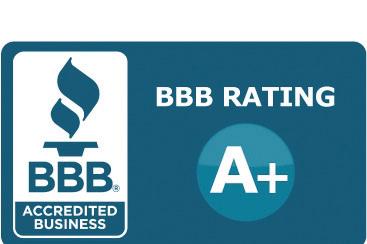


Nonprofit Spotlight. Her Second Chance is a local nonprofit based in Boca Raton dedicated to empowering women in recovery from substance abuse. The organization provides paid employment opportunities within a safe and supportive environment, helping women rebuild their lives. Founded by Keely Copeland, whose own journey through sobriety inspired the mission, Her Second Chance addresses the critical challenge many face—securing stable employment during recovery. I had the privilege of visiting Her Second Chance recently and was warmly welcomed by Operations Director Angie Maya, Board President Christopher Malfitano, Board Member Mark Guzzetta and team member Kristen Bibikos. For more information, visit https://her2ndchance.org/. If you require assistance, please contact our office at (561) 355-2204 or email Mwoodward@pbcgov.org.
featured unlimited tastings, craft drinks, live music and a spirited Centennial Cocktail Competition.
Upcoming events include Cheers to 100 (set for August 5th at the Shops at Boca Center) and Summer Sips & Sounds—a vintage-themed wine tasting and music series running July through September—is expected to keep the celebratory momentum going throughout the summer.
The festivities will conclude in grand fashion with the 53rd annual Holiday Street Parade on December 3rd, promising more than 60 floats, bands and community groups making their way through downtown Boca Raton. Centennial merchandise, art exhibitions, storytelling initiatives and volunteer opportunities are also available through the city’s official centennial website, Boca100. com, allowing everyone a chance to participate in this historic milestone. As Boca Raton celebrates its 100th year, the centennial calendar reflects not just a century of growth but a vibrant community spirit ready for the next 100 years!
By Dale Brown, B.S., M.A., C.E.C. Dale
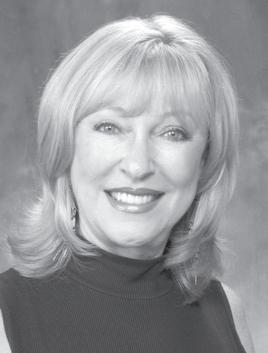
is a motivational speaker who has spent many years as a Certified Life Coach and has written numerous articles and e-books relating to self-improvement and ways to build a high-performance team. She is the author of the book, “Small Steps...Big Changes: The Personal Stories of a Life Coach.” Her education and years of experience in physical fitness and training of elite athletes has enabled her to sharpen her knowledge in many health-related areas. The following introduces a new approach to Ms. Brown’s series of columns devoted to many topics that deal with the mind/body connection and the importance of living a healthy lifestyle. Dale, a Bocaire resident, can be reached at dalebrown@lovingmondays.com
When I was growing up no one gave a thought to anything organic. My Mum shopped at A&P, went to the butcher for meats and stopped at local stands for seasonal produce. Now nearly 6% of the food Americans eat is labeled organic, and organic food sales have doubled over the past decade.
A friend recently told me she feels guilty if she doesn’t buy organic food for her family. As she puts it, “I know organic costs more but I want the best products money can buy.” This may be true but the difference in the price of some of these items makes you wonder if you’re really getting what you pay for. Is the cost higher because the label reads “natural,” “hypoallergenic,” “free range” or “organic?” Is it all a lot of marketing hype? What makes a product organic? Will my organic banana be any different on the inside once the skin is removed? You may be asking yourself the same questions.
Not too long ago I came home with a carton of organic Half & Half expecting it to taste better than the usual brand I had been buying. The first question my husband asked was, “How much more did it cost?” and the second was, “Will it taste that much better?” The answers to his questions were easy: “Yes, it cost more” and “No, there really was no difference in taste.” So why would I buy it if not for taste?
The answer to my question is more about health benefits than it is a discriminating palate. In general, organic food is considered to be healthier than non-organic. Why? Organic vegetables and fruits have 20-40% more antioxidants, and organic milk and meat may have 50% more omega-3 fatty acids. If a food is labeled “organic” it must contain at least 95% organic ingredients.
Organic food meets a comprehensive set of standards that are verified with enforceable regulations. Organic farmers build soil, reduce greenhouse gases and reduce the loss of nitrogen into the groundwater. They promote biodiversity, do not kill bees, frogs or beneficial insects.
Organic animals eat a diet free of excrement, whereas conventional farming picks up chicken litter from the bottom of the coop along with garbage, plastic roughage pellets and assert it to be protein supplement. Organic is free of antibiotics, as opposed to conventional farming, which injects animals with antibiotics.
Organic farming allows animals to feed in their natural environment and range freely. Conventional farming may be a threat to the toxic effects of arsenic through the consumption of animal products. If exposed to this metal cows may excrete it into their milk. Organic farming does not use synthetic pesticide or fertilizer, which means no residues exist. Organic crops build up a defense against chemicals, which act as antioxidants to better protect the body from cancers and heart disease.
Organic prohibits composting human waste for fertilizer. Why the price hike? Organic food costs more because it must meet strict requirements for USDA to certify it as organic. Crops are rotated more often, animal welfare standards are higher and use of chemicals is restricted. However, not all organic products cost more. Based on product comparison, on average organics were 47% more expensive but it depended on the product and where you shopped. Consumer reports showed Trader Joe’s, Walmart and Aldi’s to have the best overall prices on organics.
Sample costs and organic benefits:
• Eggs – Cost 82% more than conventional eggs. Organic – Hens are fed supplements, which increases vitamin A and omega-3 acids that improves taste.
• Milk – Big difference in cost, as much as 135% more than conventional milk. Organic – Cows are not treated with hormones.
• Beef – Approximately 134% more per lb. than for conventional ground beef. Organic – Grass fed cattle have a higher ratio of omega-3 acids that help reduce the risk of some diseases.
• Fruits/Vegetables – About 53% more than conventional produce. Organic – Pesticide risk is lower and tastes better, providing it’s grown locally rather than ripened during shipping. Nutritional difference is negligible.
When deciding what products to buy that are organic, consider what gives you the biggest bang for your buck. Why pay more for produce that needs to be peeled or skinned, such as bananas, squash or watermelon? Pesticides may not be as much a threat in this case. On the other hand, meat not treated with hormones might be worth the extra dollar.
As you can see, the issue of organic vs. nonorganic is multifaceted. From a personal standpoint it boils down to what’s
most important to you and what you can afford to pay. If you are on a tight budget trying to put healthy, nutritious meals on the table you will have to pick and choose your products. If you can afford more and are concerned about the bigger picture you may want to go organic.
There are inadvertent benefits to helping the environment while helping yourself. Organic production was designed to better the world by being kinder to the animals and not leaving the ground soaked with drugs and heavy metals. To me the choice is fairly simple: Save the environment, help the animals and, most importantly, keep myself and those I love as healthy as possible. More money, maybe, but well worth it!
By Michael J Posner,
Esq., a
partner
in Lippes Mathias LLP, a national real estate and business-oriented law firm with sixteen locations nationwide. Michael specializes in real estate and association law. He can be reached at (561) 594-1452 or at mjposner@lippes.com
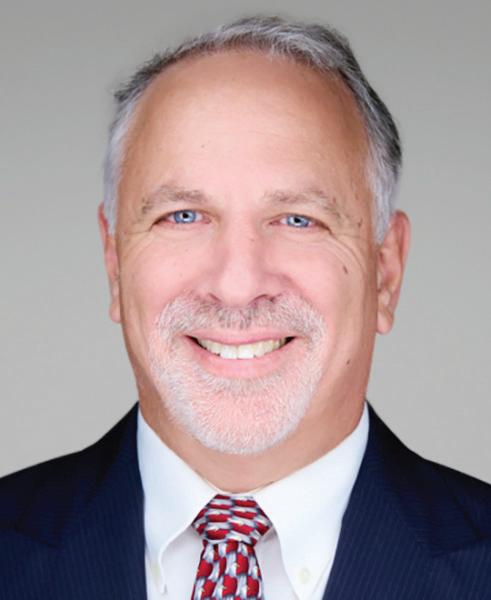
There are many pathways to wealth, but an old adage holds that the best pathway to wealth is real estate. Real estate investments can generate income from rentals and growth income from appreciation in value. While this is true, real estate can have a downside, like empty rentals, expensive repairs and depreciation in certain markets (like the one we are experiencing now). Another issue is the high bar cost to investing in real estate. Buyers need tens of thousands of dollars, and the income and credit to support a bank loan to finance the purchase.
However, there are other options to investing in real estate that do not involve actually buying actual land and buildings. One method is to invest in an entity that owns real estate and shares that property income with its investors. Recently, my internet feed has been inundated with an ad for “This Bezos-Backed Startup Lets You Become a Landlord with Only $100.” Arrived homes is a website that allows investors to buy shares in a variety of real estate projects from single family rental homes, to Airbnb rentals to providing private loans to homeowners.
Entities that offer investors the ability to buy into real estate are commonly referred to as Real Estate Investment Trusts, or

• Oil Paintings
• Oriental Rugs
• Tapestries
• Fine Furniture
• Service Plates

REITS. REITS were created in the 1960s to provide a mechanism to make real estate investing more accessible by creating a vehicle that allowed average investors the ability to invest in large-scale real property portfolios which were previously only available to institutions and wealthy individuals.
The main character of any REIT is the requirement that the entity must distribute at least ninety percent of its taxable income to its investor owners. This is unlike most companies that pay only a small or no portion of their taxable income to their investor owners (instead holding that income to use for investments, innovation, and maintaining stability in uncertain economic times).
REITS take investor funds, pool that sum together and purchase real estate, make mortgage loans secured by real estate or offer a hybrid of ownership and mortgages. Large REITS own or make loans on shopping centers, apartment buildings and other commercial buildings. Smaller REITS, like Arrived, have small acquisition, even a single property. REITS can be either public or private. A Public REIT is traded on an exchange and the interest in the REIT can be sold in a manner similar to stocks and bonds. Private REITs are not traded on public exchanges and therefore are not liquid. The advantage of a Private REIT is the potential for larger returns in exchange for a long-term investment (which can vary between one and five years or longer).
The main attraction of the REIT is the potential for high dividend yields from rental or interest income of the REIT coupled with potential appreciation from the change in property

• Sterling Silver
• Objects of Art
• Sculptures
• Bronzes
• Porcelain
• Collectibles
• Fine Crystal
• Orientalia
• Tiffany Items
• Clocks

By Alan Serinsky of Bocaire
Country
Club.
Hungry Al’s love for food started very young. Never satisfied with his Mom’s dishes, he started to cook his way through her “Betty Crocker Cookbook.”

During the years to follow he spent many hours working in restaurants, both as server and cook, attending cooking classes and traveling the world in an effort to expand his palette. As a professional writer, Hungry Al offers his perspective on current food trends and guides you through your local restaurant options.
Rose’s Daughter
169 NE 2nd Ave.
Delray Beach, FL 33444
(561) 271-9423
rosedaughterdelray.com
What took so long? I realize there are lots of restaurants in both Delray Beach and Boca Raton. And I wish I could say I’ve been to all of them, but that would leave little for me to write about. Sometimes it takes a destination or activity that motivates you to investigate another city or street for a restaurant unknown. In my case it was a concert at the Arts Garage in Delray Beach. As a sidebar...I highly recommend you look at the live event calendar on their website. They truly bring in some amazing music artists who perform in a very intimate setting. Since the concert started later in the evening it made sense to dine in close proximity. Also, the Arts Garage is on the bottom of a parking garage, which is a perfect place to park in crowded Delray Beach.
As for Rose’s Daughter, it’s been there since 2019 on the quiet street of 2nd Avenue. I must admit that I’m starting to favor these small independent restaurants over all the corporate and chain restaurants relocating to Palm Beach County. This homey local dining establishment is a perfect example that fits my taste for many reasons.
First Impressions: There are certain restaurants that instantly give you that “feel-right-at-home” vibe. Rose’s Daughter is certainly one of them. Once you step beyond the street dining patio you feel the energy of friends and acceptance. Because of its immense popularity there are no reservations, so don’t go with Open Table or Resy. I would simply get there early before the onslaught of diners. I was also told that there could be a line forming out on the street just about at the time the clock strikes 7:30 p.m.
At first the restaurant seems small but don’t get fooled by this illusion. After entering the front door you’ll encounter a friendly hostess. Is there any chance her name might be Rose? Then, as you enter the hustling and bustling of the pizza maker and the chefs working their craft in an open kitchen, you’ll share the energy resonating from a small bar upfront. Beyond that is a small hallway dining room that leads into an enormous covered back patio and another bar.
Prime Your Taste Buds: Both Hungry Al and Hungry D passed on the typical Caesar Salad ($13) or the Prosciutto & Melon ($14) and honed in on the House-made Burrata and Heirloom Tomato ($18). For me, the Burrata is a true barometer of the quality of dishes that resonate from the kitchen. And this one didn’t fail! The soft textured outer layer and the creamyrich soft density of its inners had me thinking about booking a trip to Italy. As for the arugula and tomatoes, they played a perfect supporting role.
Pizza also plays an important part of the menu. So, to honor the certificate hanging above our heads that stated “Professional Pizzaiolo Master” we decided to order the Margherita Pizza ($16). It’s clear that this executive chef takes her career seriously. Having attended a class in Neapolitan pizza-making I was not surprised how quickly we devoured this delicious pizza. Note: This is not like your usual thin-crusted pizza. The dough on a Neapolitan pizza has a soft and spongy edge.
Straight from the Kitchen: Let me first state, there is nothing on this menu you’re not going to like. How do I know? Well, the patrons in our small dining room area were very
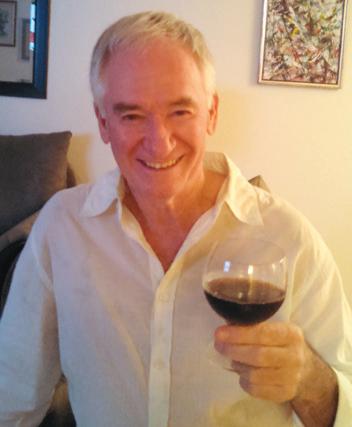
By Ed Wolfarth, who recently moved to South Florida after retiring with his wife, Vicki, as Professor of Sports Sciences & Physical Education at both Queens College and Hofstra University. He is a nationally ranked senior tennis player and long-time USPTA Elite Teaching Professional. Ed has written many educational and tennis articles in the past. Over the past few years, Ed has turned his hobby of wine collecting into a way of continuing his passion for writing and has written on the subject for publications. As a self-proclaimed “wine snob,” he has collaborated on many wine lists for private clubs and a few restaurants. Ed can be reached at wolfarthe@msn.com. Rose and white wines are the summer classics. Hot weather still lingers, but many of us are yearning for something a bit more substantial in our wine choices. There are many diaphanous red wine grapes that allow the fruit to shine through without the associated heaviness of such “winter reds” as Cabernets, Malbecs and Syrahs. Summer reds should have the following qualities: First, they should be fairly low in alcohol. Secondly, they should be low in tannins. Tannin is a natural preservative found in wine skins that makes you pucker, like the taste you get from teabags that steep too long. Thirdly, they should have good acidity to stand up to typical summer fare like salads,
Legal from page 10
value that may be realized at the end of the investment hold period (especially for private REITS). The average yield from REITS is in the three to eight percent range which is substantially higher than the average dividend yield from S&P 500 companies. However, some REITS have yields in excess of ten percent, but investors should understand that the higher yields mean more downside risk.
Most REIT dividends are taxed as ordinary income at the investor’s marginal tax rate rather than the lower qualified dividend rate, which decreases the after-tax gain. If a portion of the dividend comes from depreciation and other expenses, it may be treated as a nontaxable return of capital. This would result in a reduction in the investors basis in the ownership interest and would result
happy to inform us about all the dishes they had consumed. And the consensus was overwhelmingly positive!
As for Hungry D, she ordered the Sautéed Jumbo Shrimp Linguini ($32). Very often you’ll see this dish with small U-12 shrimp. Not here! These perfectly cooked ones stood up to their description of “Jumbo” and the linguini was also perfectly al dente. The good news for me was that the garlic was not overly handed and a “kiss good night” was still in play!
On the recommendation of our waiter Hungry Al selected the Woodfired Branzino Oreganata ($32). It was a signature entrée and now I know why. Properly seasoned with a nice, crusted layer of fresh oregano and wood-fired at the right temperature, it was nestled in a lobster reduction sauce, which only made my fork move at twice the speed. It was accompanied by Broccolini Sage and Conchiglie pasta shells, which could have used a bit more flavor.
From the Dessert Tray: I was informed by our excellent waiter, Shannon, that desserts are made in-house. Now you could stay traditionally Italian and order the gluten-free Tiramisu, Cinnamon Zeppole or Cannoli. When I’m in Italy there are a few times I’ve resisted a dish or cone of Gelato after dinner. This is not one of those times. That’s because the Gelato is also made in-house. These two huge scoops of Vanilla and Cinnamon laced with Caramel Swirl Gelato ($11) will have you licking the plate as your glycemic index shoots through the roof. They need to pack this gelato up and go retail.





Check, Please: OK, now for the answer to the $60,000 question: Who is Rose’s Daughter? Her name is Chef Suzanne Perrotto. Not only has she mastered her skills behind a stove but also as a restaurateur. For the record, she owns the very popular restaurants Brule Bistro and The Pantry, both in the Pineapple Grove area. There is a good reason why Rose’s Daughter is jampacked every night and, hopefully, this review is another one. Please don’t wait as long as I did. So, as they do in the hit series, “The Bachelor,” the Hungry Squad awards Chef Suzanne four golden roses for excellence and one to Rose as a good MOM!
tomato sauces, etc. And finally, they should taste great when chilled! The following wines certainly fill that bill.
Gamay is often referred to as “a poor man’s pinot or Burgundy.” The Gamay grape is the foundation of all Beaujolais wines. Remember, Beaujolais is the region and Gamay is the grape. You’ve probably heard of Beaujolais Nouveau, that light quaff that hits the U.S. market early every November and sells for $5 to $10 per bottle. This is a wonderful summer wine, has all three of the characteristics of a summer red, but the single vineyard Gamays are really the wines to seek out.
In order to separate themselves from the Nouveau variety these single vineyard Beaujolais do not even have the name Beaujolais on the label! These cru wines, from heaviest to lightest, are: Morgon, Moulin-a-Vent, Chenas and Julienas, Cote de Brouilly, Fleurie, Saint Amour, Brouilly, Regnie and Chirobles, which is the lightest. These are terrific summer wines that age well.
New Zealand Pinot Noir. With the exception of Beaujolais, these are the best red wines to chill. The fruity flavors are a perfect match for the summer heat. Pinot usually survives best in cooler climates. In New Zealand the Marlborough and Martinborough regions seem to fit the bill. Villa Maria, Geisen, Palliser Estates, Brancott and the famous Cloudy Bay which started it all, are making excellent and affordable Pinots that taste fabulous chilled.
in recaptures at capital gains rate if the sale of the interest is made depending on the holding period.
In addition to public and private REITS, investors can also invest in REIT ETFs, which are funds that own and hold multiple REITs. This results in lower risk, especially if one REIT fails due to either a bad economy or issues regarding their portfolio choices. REIT ETFS all carry some sort of load or fee. For example, XLRE is an ETF that hold shares in a variety of REITS (Telecom Tower, Industrial, Data Centers, Retail, and Self-Storage to name a few). It holds over 7 billion in assets, has a low load of juts 0.08%, trades presently in the low $40 range and is yielding 3.34%.
Investing in REITS as part of an overall investment strategy allows investors to incorporate real estate into their holdings without the costs and issues of direct real estate ownership.
Grenache/Garnacha, grown around the world, is often a blending grape. It is characterized by low acidity and soft tannins, and is fruit-forward. You may have heard of GSM blends from the Rhône Valley of France. That’s Grenache, Syrah and Mourvedre. In southern Australia these GSM blends are prevalent, and their fruitiness and lack of tannins make them an excellent candidate for summer drinking. If you can find it my favorite GSM blend is Nine Popes by Charles Melton. It will set you back some $40 but is a lot cheaper than many Chateauneuf-du-Papes. Garnacha, in Spain, is also used in Rioja wines. Rioja wines are nice summer reds but Garnacha in Priorat, another Spanish wine region, tends to be much heavier with more alcohol content. Just shows that all grape varietals can be made in different styles.
Zinfandel. For many years Zin was thought to be indigenous to California, until DNA testing proved that it really originated as Primitivo in Croatia. Californians cannot claim it to be theirs any longer! Zin is characterized by bright acidity and red fruit flavors. These are the “go to” wines for all foods on the barbeque. In California my favorite Zin producers are: Joel Gott, Carlisle and Seghesio. All affordable in the $15 to $25 range. For more upscale and expensive Zins, Helen Turley wines are renowned and sought after. While red Zinfandel wines tend to be high in alcohol the acidity can tame the heat. Don’t be afraid to add an ice cube.
So there you have it. It’s permissible to drink red wine in the summertime. As a matter of fact, remember my first rule of pairing food and wine. This is important, so pay attention. “Eat the food you like, with the wine you like.” Till next time...enjoy!

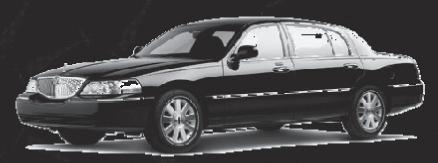

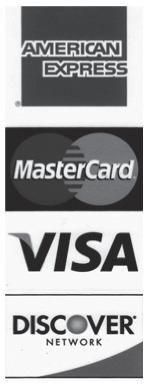
By
Nils A. Shapiro. Nils began his career as Marketing Director for a major book publisher. He has since edited the authors’ manuscripts’ for more than 20 published books, written more than 200 book reviews, served as Publisher of several million-plus circulation national magazines, created the official Yearbooks for teams in Major League Baseball, the National Football League, National Basketball Association and National Hockey League, and “retired” as President of a successful telecommunications company before being appointed Editor of Boca Club News when the newspaper was launched in January 2007.
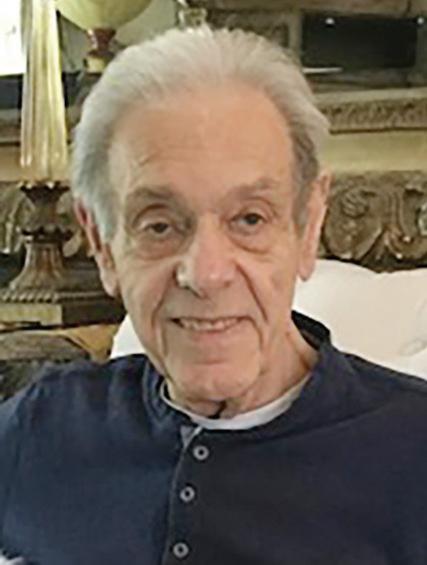
Among the hundreds of books I have reviewed for this column over the years were a dozen or so selected just because they have been on offbeat, quirky subjects with— as in this month’s case—titles that instantly grabbed my attention. And they often share the feature of not having to be read from first page to last in proper sequence. Instead, as is true of the book reviewed here, you can turn to any chapter, spend about 15 minutes in absolute fascination…and then turn to another chapter anywhere else in the book when you have time.
One thing is certain: You will learn a great deal about the history of mankind from these 17 chapters, each averaging about a dozen pages, that cover a period from three million years ago to 1,000 years ago. Author Cody Cassidy’s impressive research for this book includes conversations with the world’s leading archeologists, scientists and scholars, and he combines these with his own delightfully light writing style. Among the chapter headings whose answers the author seeks to resolve, in addition to the one in the book’s title, are:
• Who Invented Inventions?
• Who Invented Clothing?
• Who Performed the First Surgery?
• Who Was the Murderer in the First Murder Mystery?
• Who Told the First Joke We Know?
• Who Discovered Soap?
• Who Drank the First Beer?
• Who Painted the World’s First Masterpiece? …and eight more.

To be fair, the author does not claim to identify the specific individual responsible for accomplishing any of these achievements. But I found that of no importance because the treasure trove of information one learns in the description of each event—as he sets the context of that period in human history—is so thoroughly convincing that the man or woman he names as the answer to that chapter’s question becomes a satisfactory stand-in.
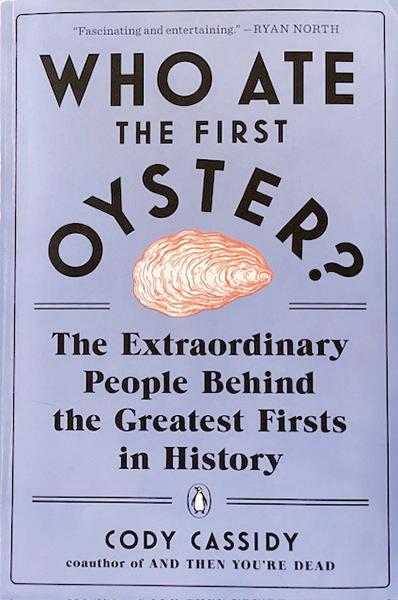
The following very brief excerpt from the chapter, “Who Invented Inventions?,” offers just a taste of what you will find in these pages. For lack of space here I am including only a few sentences from a text that covers five pages in the book—missing text is indicated by ellipses… but my purpose is to demonstrate the wealth of information and wonderful writing style that awaits you in this book:
“Who was the first inventor?
“I’ll call her Ma, because she was a young mother who, like all inventors, had a problem.
“Ma was born approximately 3 million years ago and belonged to an ancient ancestor species of ours called Australopithecus. She was born in Africa, perhaps Eastern Africa, where archeologists have discovered a concentration of australopithecine fossils, including the famous ‘Lucy’ found in 1974. Three million years ago is approximately halfway from the time our species first split from the chimpanzee and bonobo line to the modern day…Ma represents a middle ground between Homo sapiens and chimpanzees.
“She stood almost four feet tall, weighed a lithe sixtyfive pounds, and other than on her hairless face she was covered in thick dark fur. Ma ate more meat than a modern chimp does, but she scavenged it rather than killed it. Ma supplemented her meals with roots, tubers, nuts and fruits. In many respects, a modern observer might mistake her for a remarkably well-balanced, walking chimp, save for her peculiar, dexterous and inventive use of rocks. To aid her work scavenging carcasses, Ma sharpened stones to cut into bones for marrow, which allowed her to eat meat scavengers couldn’t access.
Now Feed 6 Shelter Dogs and Cats Every Day at No Cost to You ... in Less Than a Minute ... with just a “Click”
Want to feel really good about yourself? If, like most of us, those TV announcements bring tears to your eyes with photos of sad shelter dogs and cats in small cages, hoping somehow to be brought into loving homes – when you wish over and over again that you could somehow bring joy into their lives, here is an act of loving kindness that will cost you absolutely nothing ... and take less than a minute a day.
Visit the website: www.theanimalrescuesite.com and click on the words “Click here to feed a dog or cat.” A “button” will appear on your screen, and all you have to do is click on it once. Each time a person clicks on that button, the website’s sponsors provide bowls of food, free, to feed 6 dogs and cats.
That’s all there is to it. In only seconds each day, you can see to it that 6 animals are fed. The folks who run the website never bother you with tons of promotional e-mails. You can, if you wish, click on a link that sends a daily reminder to you. I did that; the reminder is e-mailed, and that is it. No hard-sell follow-ups. And if you realize how good it will make you feel to be able to do at least something for these poor, loving creatures who are there through no fault of their own (some have been rescued from abusive owners), imagine how even bowls of food will help make the animals feel better.
Please take just seconds a day to lift 6 animals’ spirits ... and your own. Thanks.
“Ma was a clever ape, but to many of Africa’s big cats she was still lunch…
“Ma’s raw diet meant she would have had to spend nearly
HAPPY HOUR: Celebrating our10year anniversary
her entire day gathering food and eating it while dodging eagles and panthers, clambering up and down trees, and roaming across open ground looking for carcasses and fruit.
“All of which would have become far more difficult when, in her early teens, Ma gave birth to a noisy, helpless, immobile infant.
“Homo sapiens infants are an evolutionary curiosity. Most mammalian babies are born ready to walk, trot, or at least hold on to their moms. The reason is blindingly obvious: Every day a baby spends unable to keep up is life threatening for both mother and child. A capuchin monkey’s baby can grip its mother’s fur almost immediately, while the biggerbrained chimpanzee’s mother has to carry her newborn, but only for its first two months. Homo sapiens babies, on the other hand, spend more than a year in almost complete helplessness, unable to walk, crawl, or even support their own body weight. While this would seem an evolutionary disaster, it is the downside to what is perhaps our greatest strength: oversize brains. Our extended weakened state is partially explained by the time required to develop trillions of synaptic connections within our brain. In all primates, an evolutionary trade-off occurs between larger brains and infant mortality, and each species has arrived at its own equilibrium…
“The switch to bipedalism (walking upright) nearly 3 million years ago would have placed mothers and their newborn in a dangerous position…upright walking requires narrow hips, which would have narrowed the birth canal and necessitated smaller-headed babies. But instead of hominin heads shrinking, and hominin babies becoming more capable, the exact opposite occurred. Head size increased and babies became even weaker…
“The evolutionary explanation for the paradox is that hominin mothers like Ma birthed their babies earlier in their gestation. Essentially, Ma’s baby was born two or three months premature, before its head could outgrow the exit…If Homo sapiens birthed babies at the same development stage as chimpanzees, pregnancy would last twenty months.”
In order for her species to survive, this mother would have to find a way to get food for herself and her helpless baby without leaving the child vulnerable to predators. How she solves it with the “world’s first invention” is just one example of the author’s combination of creative curiosity, intense research, convincing logic and compelling narrative that easily forgives the impossibility of pinpointing the actual specific individuals over millions and thousands of years whose names would answer the questions asked in the chapters’ titles. An extraordinarily informative and entertaining book.
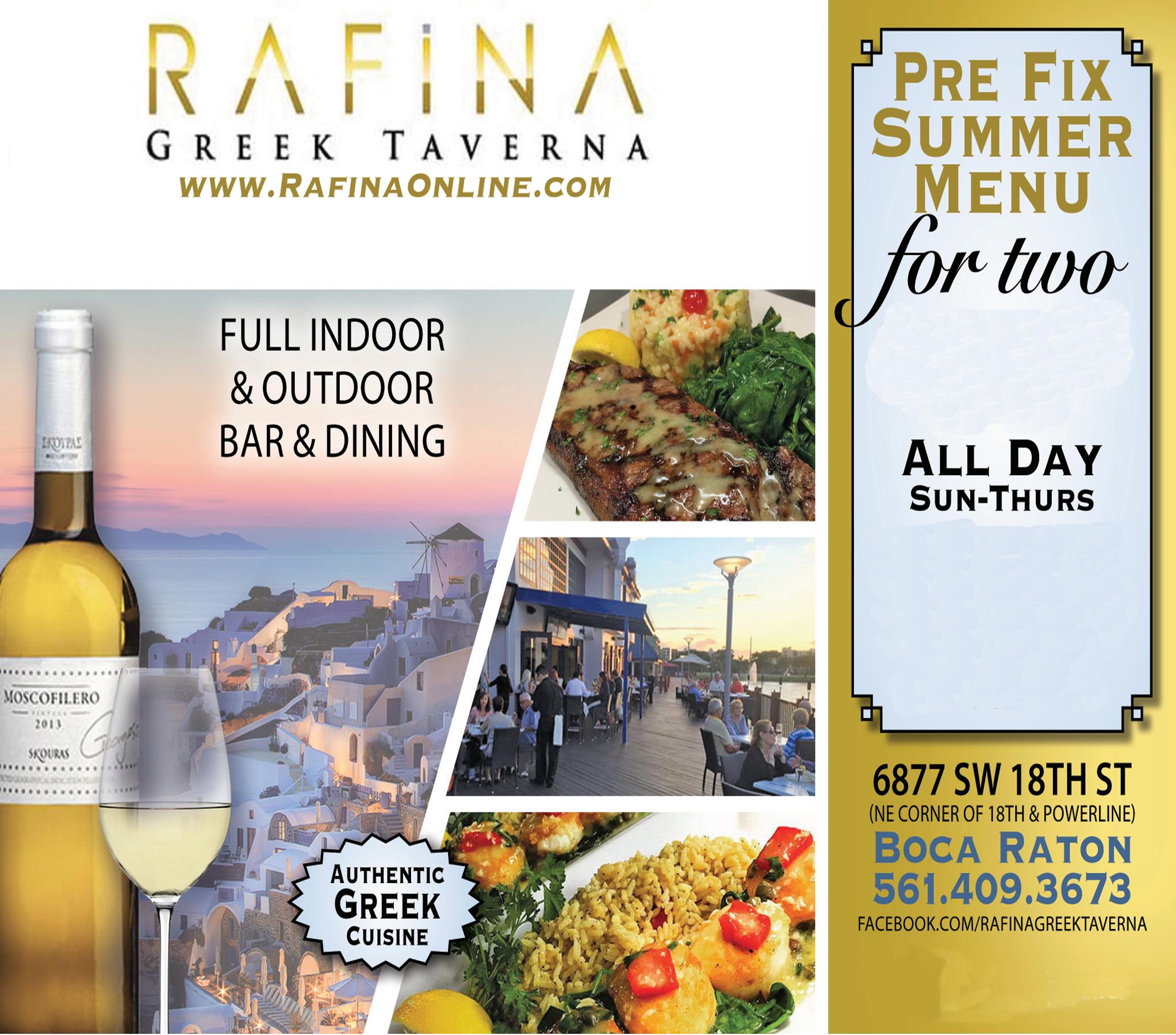

Sonia Ravech is a native of Massachusetts and a resident of Broken Sound for more than 30 years. She is the mother of four, grandmother of seven, and great grandmother of six. She is the facilitator of two Writing Workshops at Broken Sound.
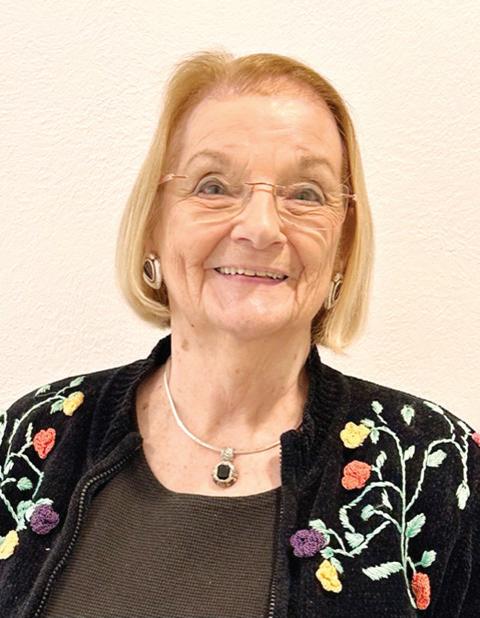
An elderly couple sat across from me in a restaurant. The woman had apparently suffered a debilitating stroke and was in a wheelchair. When their food arrived the gentleman tied a bib around the woman’s neck. He cut her chicken into bite-size pieces and proceeded to feed her. Her head hung slack and saliva filled the corners of her mouth. Occasionally, he wiped away the spittle from her lips and chin with a napkin. He raised a glass so she could sip a drink from a straw. His own meal grew cold as he concentrated on helping her.
He spoke tenderly to her and patted her hand reassuringly. When their meal was finished he rose from his chair and helped her into her sweater. He brushed the silver strands from her face and kissed the top of her head. She lifted her eyes towards his and tried to smile. It was obvious to all who observed this scene that this man was completely devoted to this woman.
As he looked into her face I wondered what he saw. Was it the face of the helpless invalid that was seen by others in the restaurant, or that of the beautiful bride he wed so many years before?
From the love that radiated from his eyes I’m convinced it was the latter.
The Conversation
Two elderly gentlemen, looking bored, sat on a bench in front of a women’s clothing boutique. One nodded to the other, “Nice day out there, isn’t it?”
“It’s a beauty. A great day to be on the golf course instead of sitting here waiting for my wife to shop,” the second responded.
“Are you a golfer?” the first gentleman asked.
“I love the game. I used to play several days a week until my wife developed macular degeneration. Now she can’t drive and I’m her chauffeur. Every Monday we go to the market. On Tuesday she plays Canasta. Thursdays she has her nails done. Saturday she goes to the beauty parlor. There’s no time for me to get in a game. What about you? Do you play?”
“I’ve played a few times, but I can’t say I’m a fan. I’d rather play tennis.”
“That’s great exercise, I’ve been told, but I never tried it. How often do you play?”
“I used to play twice a week but almost two years ago my wife was diagnosed with pancreatic cancer. She went through Hell with chemotherapy and radiation. Then a few months ago her kidneys failed and now she’s on dialysis twice a week. So, between taking her for treatments and going to the doctor, and doing other errands, there’s not much time for tennis.”
“I know what you mean,” the second gentleman shrugged, “but what are you going to do?”
The Newlyweds
He was an elderly African-American with watery eyes and grey stubble of a beard. He wore black sweatpants, a beige corduroy jacket and a green knit hat pulled down over his ears. He walked with a cane.
By Nils A. Shapiro
There are months when I can view the offerings of HBO, Netflix, Amazon Prime and other movie channels and consider myself fortunate to find a single film deserving of bringing to the attention of this column’s readers. So when my wife, Linda, and I very much enjoyed the two features discussed here—both streaming on Netflix—I decided to share them with you as a rare “double feature” review. It was a certainty that “Hitchcock” would be a treat. With a cast that includes Anthony Hopkins, Helen Mirren, Scarlet Johansson and Jessica Biel, a music score by Danny Elfman—and a story line based on the enormously successful non-fiction bestseller, Alfred Hitchcock and The Making of “Psycho,” by Stephen Rebello—the only surprise for me was that I had not before heard of this 2012 film.
After experiencing an extraordinary performance by Anthony Hopkins as the legendary director—his physical appearance closely matching Hitchcock’s thanks to an

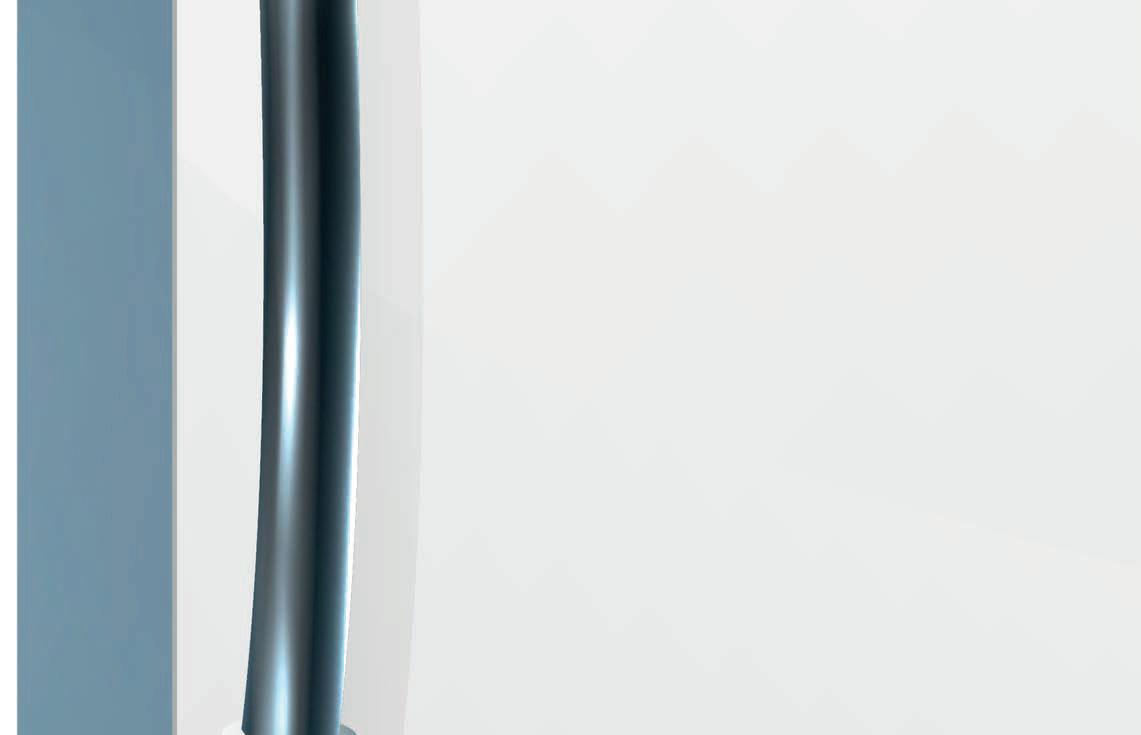
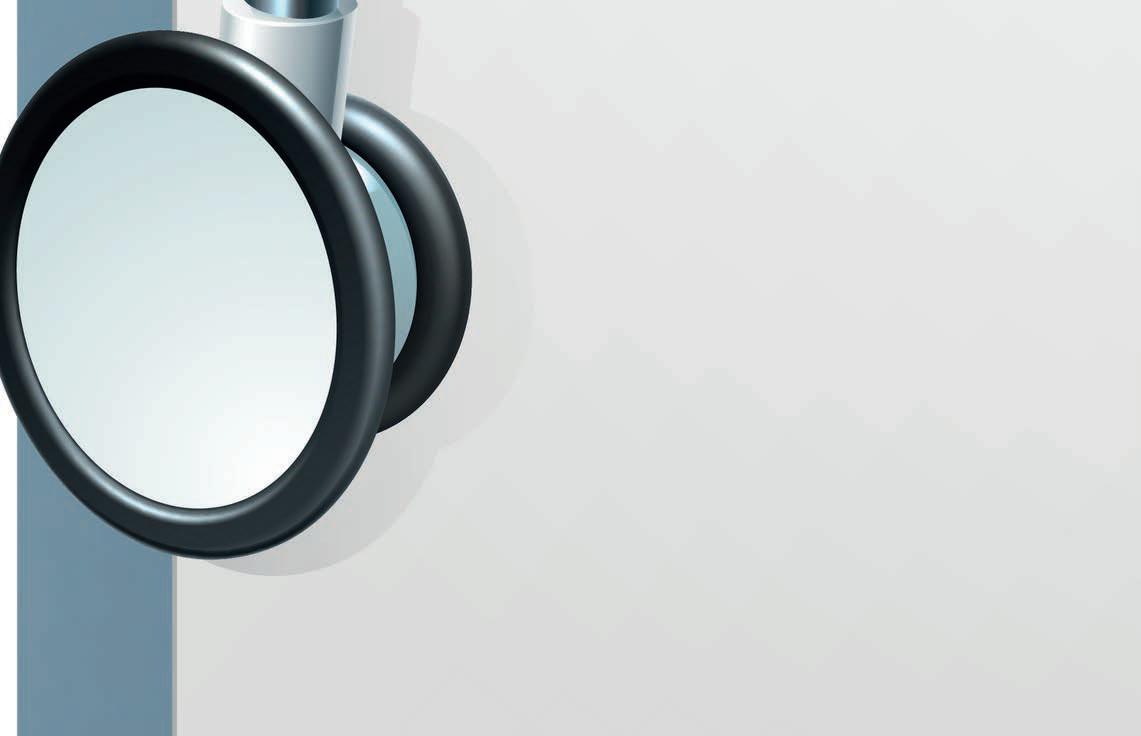
Oscar-worthy assist from the production’s make-up crew and a convincing weight-adding body suit—and witnessing the kind of genius that went into what became one of his genuine classics, we are reminded by the end credits that Hitchcock never won an Academy Award!
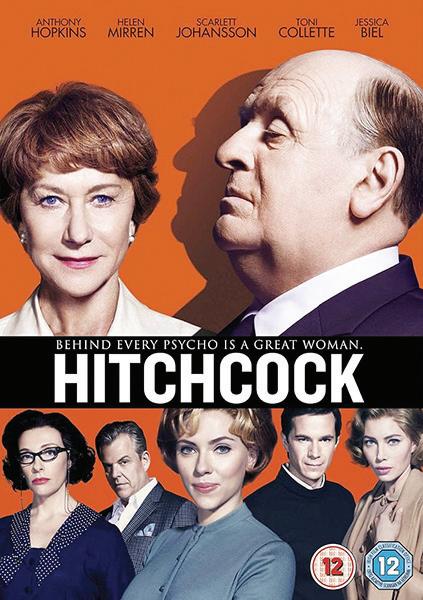
Equally impressive is Helen Mirren’s role as his wife, Alma Ravelle, who supported him in every way possible—creatively in real life when he turned down such scripts as The Diary of Anne Frank and James Bond’s Casino Royale, and financially when she agreed to mortgage their home in order to finance the production of Psycho after Paramount Pictures refused to provide the funds. So it is shocking when this film, based on the purportedly

She was a stocky, elderly Caucasian who wore glasses. She was dressed all in white; white sneakers, white slacks, white blouse, white jacket and a white floppy hat with several stray wisps of white hair peeking from underneath the brim. She shuffled slowly behind him pushing a walker for balance.
The waitress showed them to a booth at the IHOP restaurant and handed them menus. “Please bring us two cups of coffee. It’s chilly out there today,” he said.
“Right away,” she replied.
She returned a short while later with the coffee and asked for their order, which they proceeded to give her. Then, within earshot of others seated around him, the gentleman announced proudly, “We just got married yesterday.”
“Well, good for you,” the waitress commented.
As they waited for their meal to be served he reached across the table and held her hand. Several minutes later the waitress brought their eggs and pancakes and refilled their coffee cups. She left them to enjoy their meal but returned within minutes carrying a waffle with a mound of strawberries in the center surrounded by a whipped cream heart.
“A special occasion calls for a special treat,” she said placing the waffle in front of them. A broad grin passed across his face. His wife clutched her chest in joyous surprise. The other patrons seated nearby applauded the happy newlyweds.






true book, suggests that the intense stabbing in the famous shower scene being dramatically directed by Hitchcock here is motivated by a moment of fury when he visualizes it as an attack on his wife, Alma, because he suspects her of having an affair!
The initial negative reaction to the production by Paramount, Hitchcock’s decision to go back to the cutting room, the re-filming of the shower scene and Hitchcock’s brilliant idea for how to market the film to audiences in movie theaters—all resulting in one of Hollywood’s most popular and ultimately financially successful films—is a Hollywood history well worth your time. *****
Very different in many ways is “The Heart Knows,” a production from Argentina whose actors will be so unfamiliar to this column’s readers that to name them here would serve no purpose, and the excellent dubbing into English ensures full enjoyment of the film, which debuted in the U.S. on Netflix May 30th.
The phrase “a change of heart” describes this story in more ways than one.
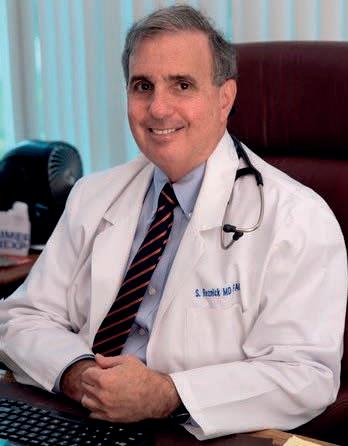



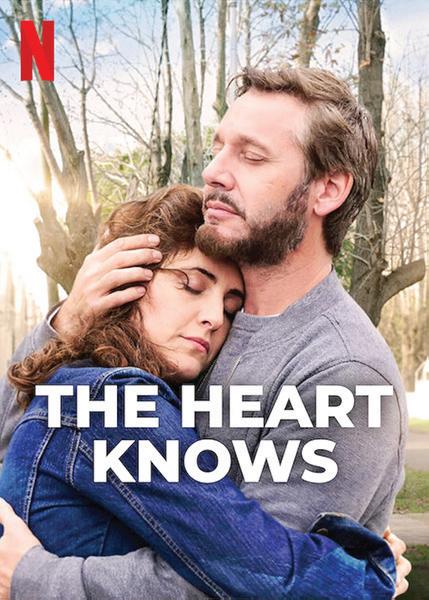
Juan Manuel is the young, handsome, dynamic head of a large and successful construction company, Concreter, who one day suddenly collapses, is rushed to a hospital and diagnosed as needing an immediate heart transplant. At the same time another man on a motorbike, a husband and father who lives in a poor part of town called El Progreso, swerves to avoid an accident, crashes and dies of a fatal head injury.
When the hospital learns of the accident, and that the victim had been a registered organ donor, they quickly arrange to transplant his heart into Juan Manuel.
Several months later, healed to the point of being able to travel around and wanting to know more about the man whose heart is now his, Juan Manuel visits the neighborhood of El Progreso but does not dare to identify his true self for it turns out that his company, Concreter, is its residents’ hated enemy that is planning to tear down the homes, schools and community center in order to build a wealthier area…and he himself has been in charge of the project! Instead, he pretends to be a poor worker, one of them.
What happens when Juan Manuel meets Val, the heart donor’s widow, and young son Pedro—and how that different affair of the heart affects his feelings and actions regarding the company’s plans—is the very heart of the film.
It is only fair that I tell you the critics were not very kind in their reviews of “The Heart Knows” when it was first released, but it climbed quickly to Netfilix’s number one most-watched feature. I can understand why; Linda and I found it quite lovely. You decide for yourself.
By Andrew Turkell, DVM & AI,
Calusa Veterinary Center, 6900 Congress Avenue, Boca Raton, FL 33487, 561-999-3000, www. CVCBoca.com
Advanced technologies promise to revolutionize diagnosis, treatment and preventive care for animals across all species.
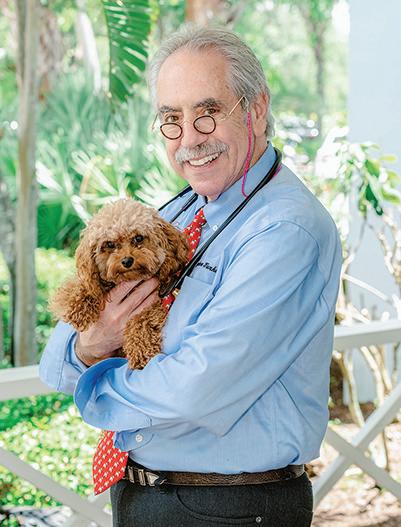
The veterinary industry stands on the brink of a technological revolution as artificial intelligence systems become increasingly sophisticated and accessible. From small animal clinics to large agricultural operations, AI is reshaping how veterinarians diagnose diseases, develop treatment plans and monitor animal health.
The most significant impact of AI in veterinary medicine is emerging in diagnostic imaging. Machine learning algorithms can now analyze X-rays, ultrasounds and CT scans with remarkable accuracy, often identifying subtle abnormalities that might be missed by the human eye. Board Certified Veterinary radiologists report that AI-assisted imaging has improved diagnostic accuracy by 30%.
“We’re seeing AI systems that can detect early-stage heart disease in cats, identify hard to see fractures in many species and even predict the likelihood of certain cancers developing. The technology doesn’t replace veterinary expertise; it amplifies it.
Computer vision systems are also transforming how veterinarians assess animal behavior and movement. Lameness detection in horses, gait analysis in dogs recovering from orthopedic surgery, and behavioral monitoring in zoo animals are becoming more precise and objective through AI-powered video analysis.
Machine learning algorithms are enabling veterinarians to develop more personalized treatment protocols by analyzing vast collections of patient information, treatment
outcomes and genetic factors. These systems can predict how individual animals might respond to specific medications or treatments based on their breed, age, medical history and genetic markers. The technology is particularly promising for managing chronic conditions like diabetes in cats and dogs, where AI can help optimize insulin dosing schedules and dietary recommendations based on continuous glucose monitoring data and activity patterns.
AI-powered scribes are designed to assist veterinarians with their administrative tasks and improve overall practice efficiency. By automating note-taking and other documentation processes, it aims to free up veterinarians’ time, reduce burnout and enhance client communications.
The integration of AI with telemedicine platforms is expanding access to veterinary care, especially in rural areas where specialist services are limited. Smart collar devices equipped with sensors can monitor vital signs, activity levels and behavioral patterns, transmitting data to veterinary AI systems that can alert practitioners to potential health issues before they become serious.
Farmers are already using AI-powered systems to monitor livestock health on a large scale. Computer vision cameras can detect signs of illness, injury or distress in cattle, pigs and poultry, enabling early intervention and reducing the need for antibiotics.
Despite the promising developments the integration of AI in veterinary medicine faces several challenges, especially the costs of implementing new technologies which are significant barriers for many practices.
Regulatory frameworks are also evolving to address AI in veterinary medicine. The FDA and other international agencies are developing guidelines for AI-assisted diagnostic tools and treatment recommendations to ensure safety and efficacy standards are met.
“The key is finding the right balance between embracing innovation and maintaining the personal touch that’s so
important in veterinary care,” says Dr. Michael Rodriguez, president of the American Veterinary Medical Association. “Technology should enhance the human-animal bond, not replace it.”
Rather than replacing veterinarians, AI is expected to change the nature of veterinary work. Routine diagnostic tasks may become automated, allowing veterinarians to focus more time on complex cases, client communication and surgical procedures. This shift could help address the growing shortage of veterinarians in many regions.
The economic impact is substantial. Industry analysts project that AI applications in veterinary medicine could grow from $300 million in 2024 to over $2 billion by 2030, driven by demand for more efficient and accurate diagnostic tools.
The next decade promises even more revolutionary developments. Researchers are working on AI systems that can predict disease outbreaks in animal populations, robotic surgical assistants for complex procedures and AI-powered drug discovery specifically for veterinary applications.
Gene therapy treatments guided by AI algorithms, personalized nutrition plans based on individual animal microbiomes and predictive health modeling that can forecast an animal’s health trajectory years in advance are all on the horizon.
As these technologies mature they promise to deliver more precise, efficient and compassionate care for animals while helping veterinarians make better-informed decisions. The future of veterinary medicine appears to be one where artificial intelligence and human expertise work together to ensure the health and well-being of animals across all species.

